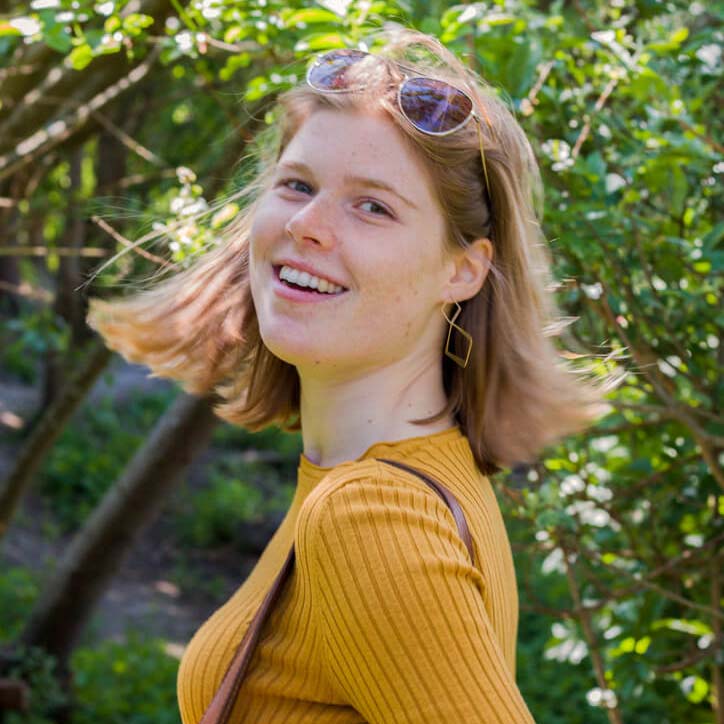While starting to type this blog post I’m enjoying the views of the Swiss Alps from the Glacier Express, one of Switzerland’s most famous panoramic trains. Picture the glowing mountain hills in a late summer sun, with in the backdrop a view of one of the country’s most famous glaciers, where ice is eternal and skiing can be done in summer. On the journey from Zermatt to Chur, I’m halfway through my 2-week trip through Switzerland, with nothing but highlights!
Traveling for 2 weeks through Switzerland by public transport? It’s possible! In fact, the Swiss public transport is one of the best and most punctual I’ve experienced so far. None of my trains has even had 1 minute of delay. And with the Swiss Travel Pass you can easily hop on any train or bus in the country. This allowed me to accurately plan this trip past some of Switzerland’s most amazing destinations. Curious? Read on to find out my entire itinerary!
Note: public transport and some activities mentioned in this article were sponsored by the Tourism Board of Switzerland. However, what you read here is my authentic experience and honest opinions of the country.
Please also note that all prices in this blog post are based on my experience in September 2023. Keep in mind that prices might have changed now.
2-week Switzerland train itinerary
Day 1: arriving in Basel
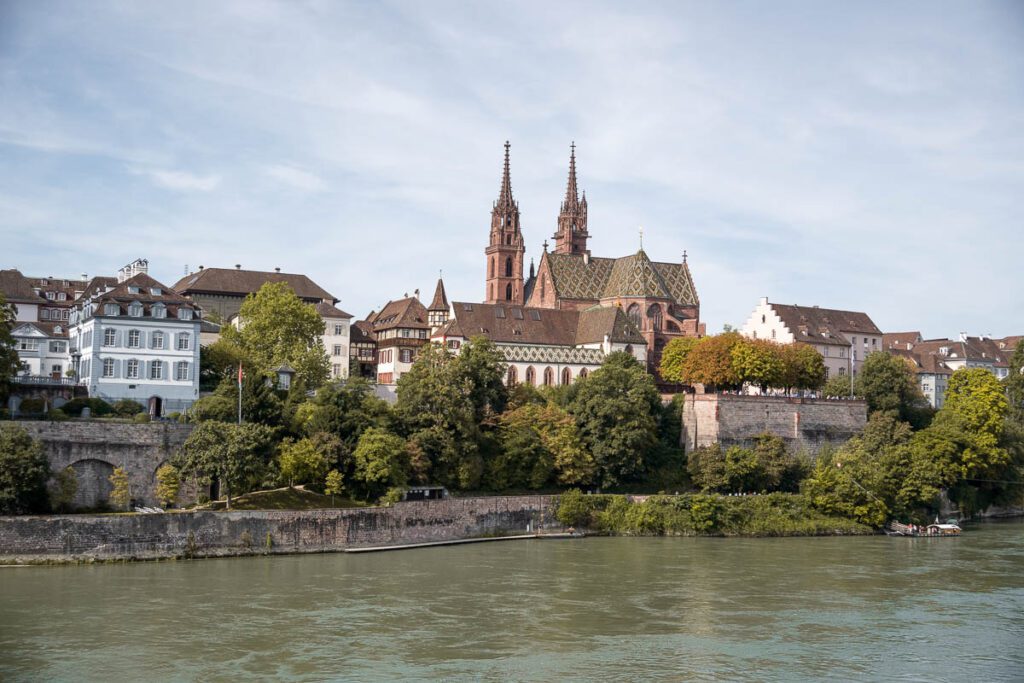
The first day of my train road trip in Switzerland I departed by train from Belgium. From Brussels, it’s only a 6-hour journey to Basel, either through Germany (Cologne) or France (Paris or Strasbourg). I easily booked my ticket online via NMBS International and paid around €150 for a one-way ticket to Basel. If you’re flying in from another destination, I recommend flying to Zurich and spending the first night there or flying to Frankfurt and taking the train to Basel.
Hint: if you’re traveling by train, make sure to book your ticket early in advance and avoid weekends. This way you can halve the price of your ticket!
I arrived pretty late in Basel so I wasn’t able to discover the city by daylight. Luckily, there were a lot of things to do by night as well! Accidentally, the Jugendkulturfestival was taking place. This festival with a lot of music performances all over Basel is being organised at the beginning of September.
Restaurant tip: if you’re arriving hungry, the perfect place to grab some dinner is the Markthalle. Here you’ll find different international food stands that offer you (affordable) food options! This might be a good way to save you a heart attack when first seeing the prices of a steak in Switzerland… Alternatively, you can visit the riverside where you’ll encounter quite a few nice restaurants.
For my quick stop in Basel, I booked a room through Airbnb with a local Swiss lady who gave me a lot of tips about the city. It’s a perfect affordable place to stay for 1 person at walking distance from all sightseeing locations.
Day 2: Basel – Interlaken – Grindelwald
Exploring Basel
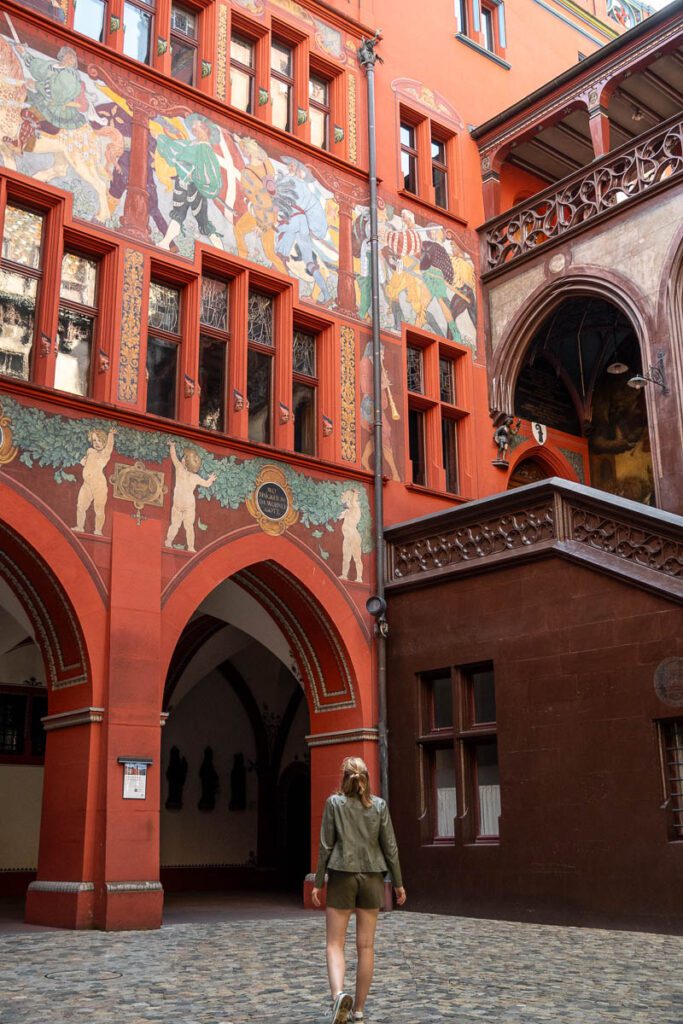
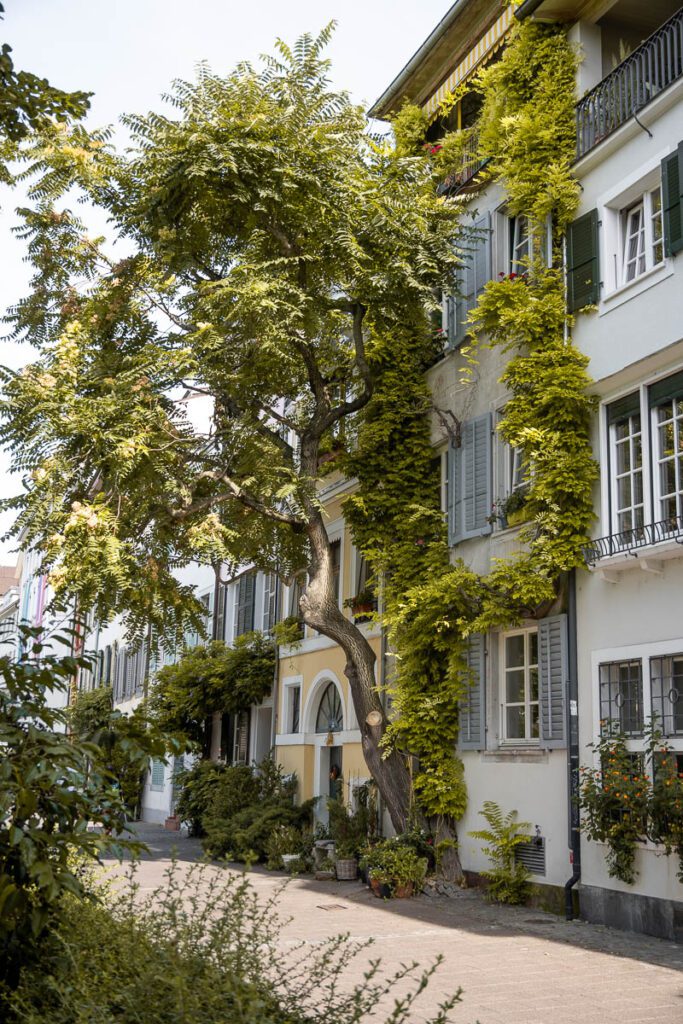
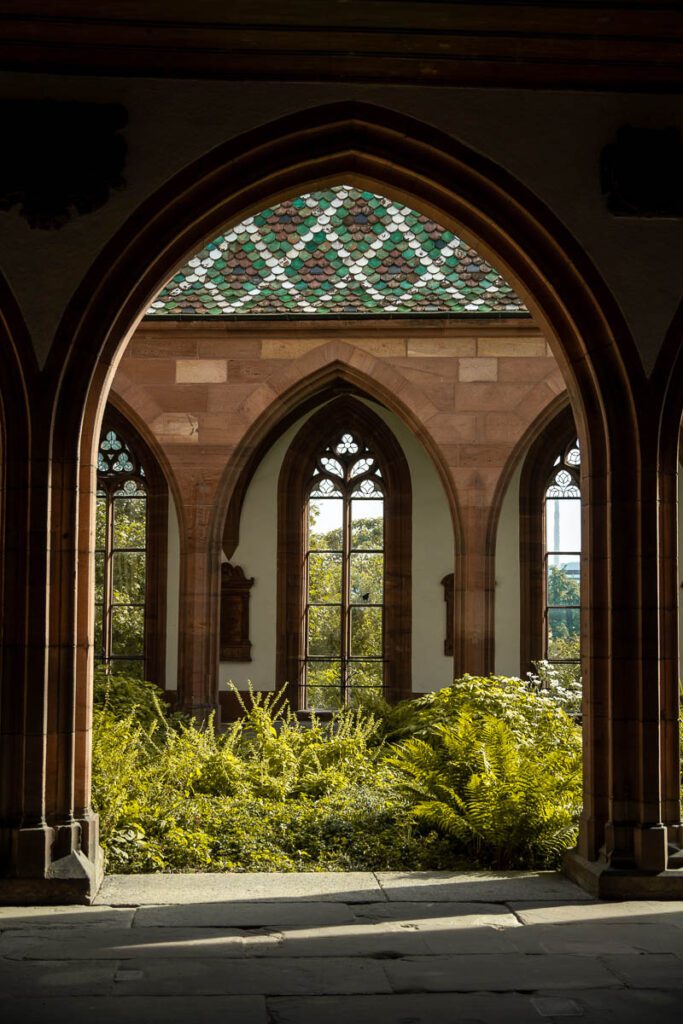
As I hadn’t been able to see a lot of Basel in daylight, I decided to explore the city the next morning! Although there is much more to see in Basel than what you can visit on a single day, let alone a single morning, it’s sufficient for a quick visit of its highlights. Here are some places you absolutely cannot miss in Basel:
- Visit Basler Münster. This church is one of the highlights of Basel! Go explore its underground crypts and also pay a visit to the Bischofshof, impressive hallways around the church. It’s all free to visit, but you cannot enter during a mass. Then the church will be closed but the halls can still be visited!
- Make your way to Basler Pfalz, the most photographed viewpoint of Basel. Enjoy the view of the river and take a selfie!
- Walk through the Rheinsprung street to the Mittlere Brücke. In the street, there’s a hidden pathway down to the Garten der Alten Universität. Most tourists don’t come here so you can have this view of the river all for yourself!
- Walk over the Mittlere Brücke. This bridge is constructed on the oldest existing bridge site across the Rhine!
- Enjoy the view from the Oberer Rheinweg along the water. This is the perfect place to take a picture but also to cross the river by boat. Cute boats hanging on cords will take passengers back and forth to the Basler Pfalz. For a small price, you can go to the other side as well.
The highlight of Interlaken
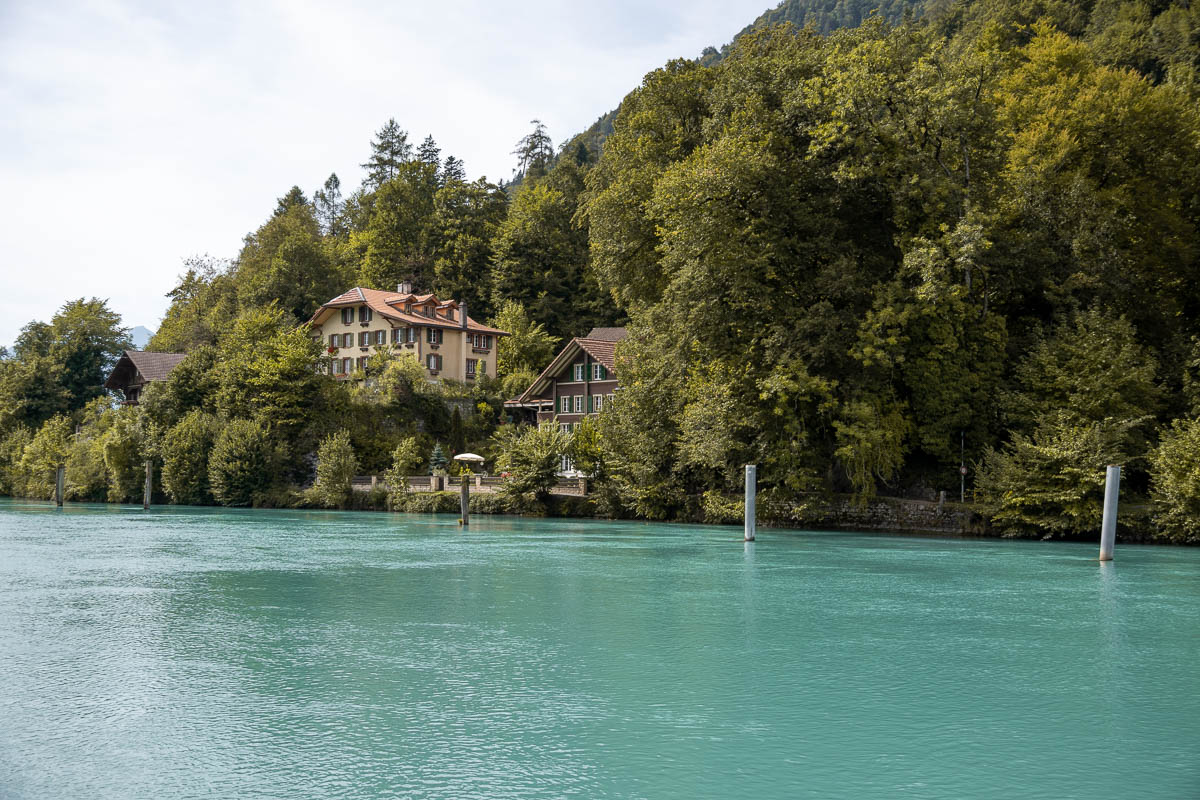
After my short visit to Basel, I immediately hopped on a train to Interlaken Ost. With the Swiss Travel Pass, I could just take any train. Yes, also the international ICE trains! How convenient is that? Enjoy the train ride because you’ll pass by the magnificent Thuner Lake. You’ll want to make sure to stop in Interlaken Ost and not Interlaken West as the former train station is much better suited for the next activity.
Once arrived in Interlaken, leave your luggage in one of the lockers at the train station. A large locker for one day cost me 12 Swiss Francs. Here I could store both my large suitcase and backpack. Super convenient!
From the train station, make your way on foot to the Harder Kulm cable car (only a 5-10 minute walk). In the distance, you can already see the snow-covered peaks of the Jungfrau region, which got me super excited! To go up and down Harder Kulm you’ll pay 34 Swiss Francs, but the Swiss Travel Pass gives you a 50% discount, so I only paid 17 Swiss Francs for the roundtrip. 🙂 Make sure to book your ticket in advance so you can skip the queue at the cable car and go up immediately. When sitting in front of the cable car you’ll have the best view of Interlaken when going up.
Once on the top at 1.322 meters, enjoy the magnificent view of the Jungfrau, Mönch, and Eiger peaks. Walk your way to the famous skywalk for an undisturbed view of Interlaken, the Thuner- and Brienzersee, and the mountain range in front of you. This is also the perfect place to enjoy the Swiss cuisine with a view, but be aware that prices up here are quite elevated.
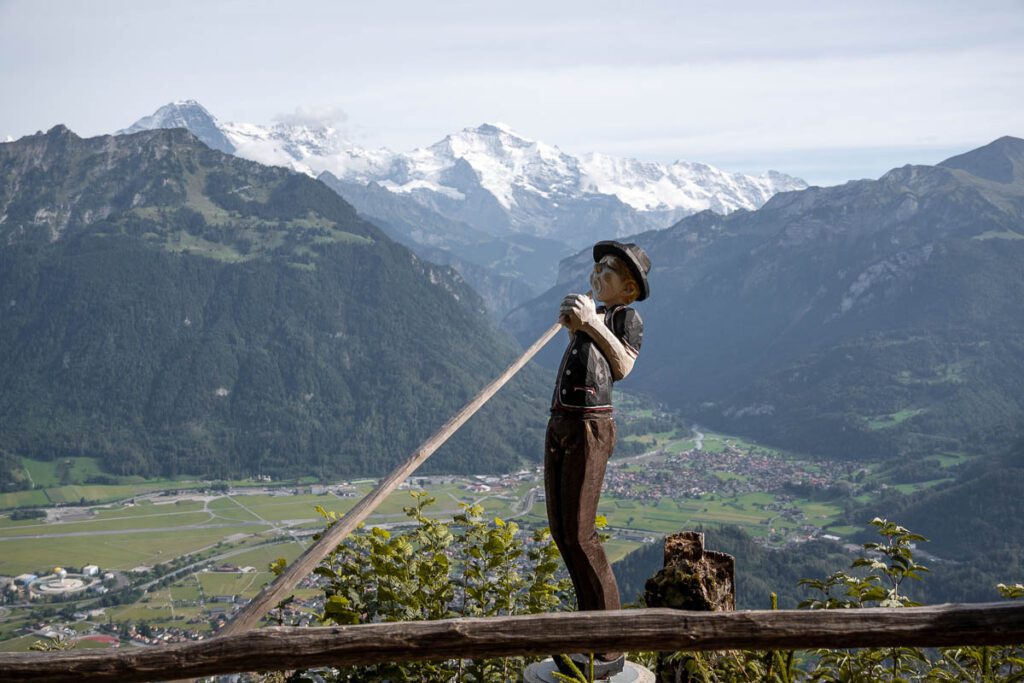
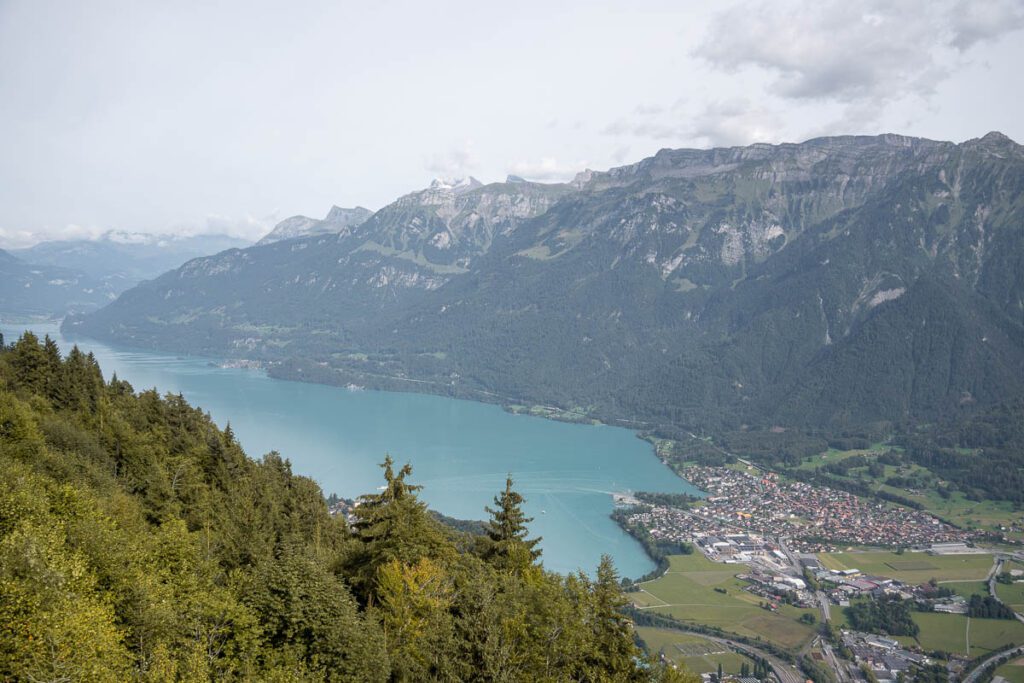
Another great activity on the top is the roundtour hiking trail which takes you for a 1 hour tour (first up then down) on the Harder Kulm. Perfect, if you’re looking for something more active! If you are really sporty, you might also consider walking up the Harder Kulm instead of going by cable car. This takes about 2.5 hours up and 1.5 hours down.
Be aware that to go down by cable car there might be quite a queue since the cable car only runs every 20 minutes. So it’s not a bad idea to take the cable car up and walk down if you’re up for it!
Settling at Grindelwald
After coming down from Harder Klum I took another train to Grindelwald. From Interlaken Ost, this only takes about 30 minutes. Grindelwald itself is very walkable so you can do everything on foot, but with luggage taking the bus might be a little bit more convenient. Luckily, that’s also included in the Swiss Travel Pass!
Hotel Tip: in Grindelwald, I stayed in Hotel Restaurant Alte Post. This cute 3-star hotel has traditional wooden rooms with a balcony and a view of the mountains. Although the rooms are not necessarily the most modern, they are affordably priced. Moreover, their breakfast exceeded all my expectations as it was loaded with local products!
After settling into my room, I went for dinner at the hotel of the restaurant, which serves traditional Swiss dishes (that are not cheese!). Definitely try their Kalbsgeschnetzeltes with rösti! And for dessert, have a meringue, I was told that this is a local specialty.
Day 3: Grindelwald
Up to Grindelwald First
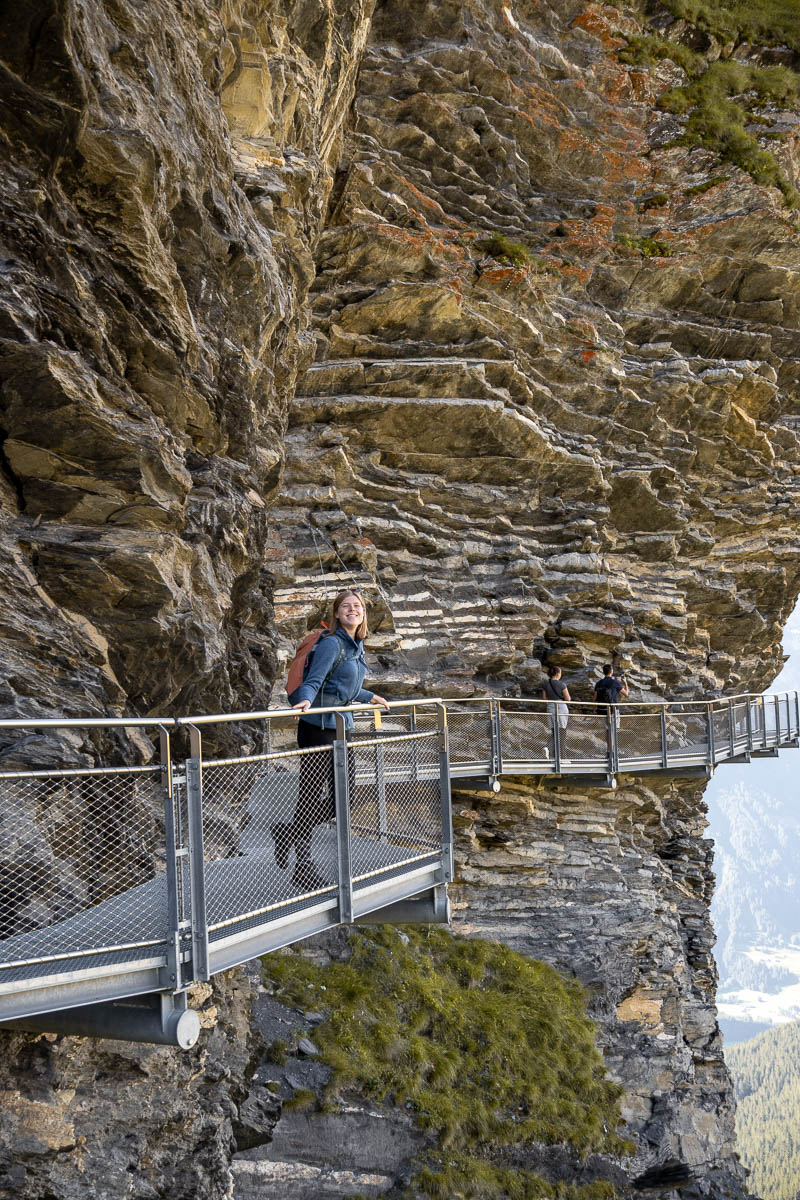
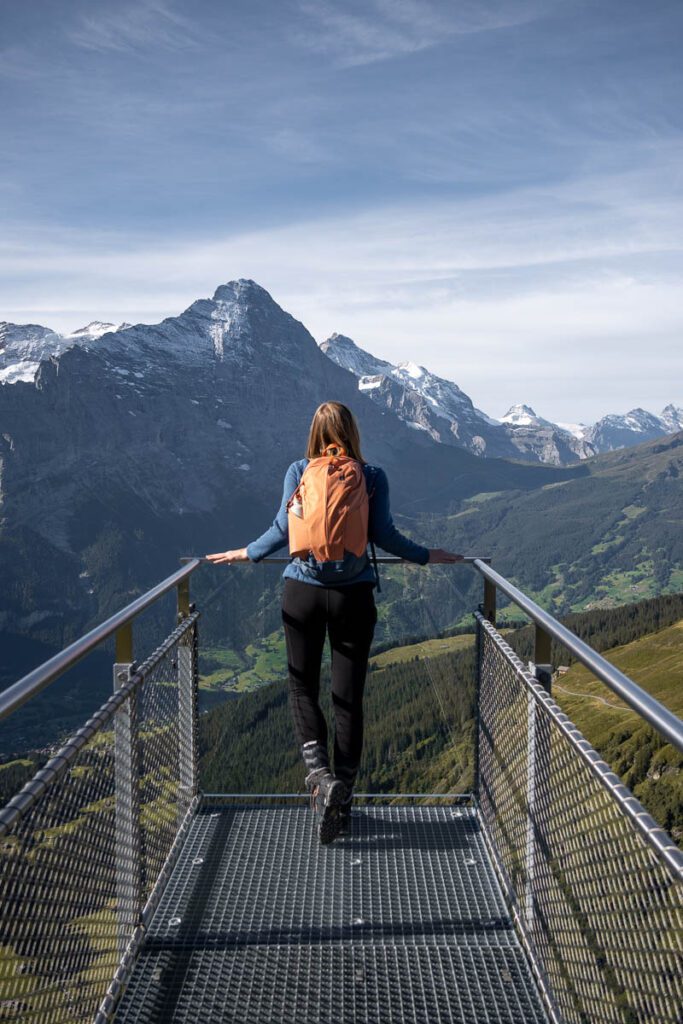
There are 2 major things you should absolutely do when visiting Grindelwald, one is the Jungfraujoch (see day 4) and the other is Grindelwald First. The First cable car takes you all the way up to 2.166 meters. And if you’re staying in Hotel Restaurant Alte Post, you have an extra advantage, because this hotel is located right next to the lift! So that means that you can be the first in the morning to go up that mountain. And believe me, you’ll want to!
You can easily spend an entire day up the mountain if you’re up for a bit of adventure. Here are the highlights you should have done:
- Walk over the First Cliff Walk by Tissot. This metal bridge hanging on the side of a cliff gives you the most stunning views! Although it’s a short walk (only a few hundred meters), you’ll end up at the most picture-perfect viewpoint. If you’re early enough (by that I mean the first few lifts) you’ll have this place all to yourself. Half an hour later you’ll need to start lining up for a picture here.
- After the Cliff Walk make your way up to “First View” vantage platform, from where you’ll have an equally amazing view of the surrounding mountains and valley.
- Hike to Bachalpsee. This lake with a backdrop of snow-capped mountains, is more than picture-perfect. In 50 minutes you’ll reach the lake from the cable car and it will take you 50 minutes to walk back the same way. The hike itself is not particularly difficult and the road is very well maintained. Nevertheless, I recommend wearing sturdy hiking shoes.
Tip: most tourists stop walking the moment they see Bachalpsee, but the most beautiful bit only comes when you’re hiking a bit further upward. Then you’ll have a magnificent view of the lake and the surrounding mountains. 90% of the tourists don’t come here so you might have this view almost exclusively to you. The catch? It’s a very steep trail uphill, which can only be hiked with the right equipment.
- If you’re a hiking addict, plan to hike further to the Faulhorn hut. Here you can spend the night but also stop for a good lunch before you make your way down again. Be aware that you should count a few more hours to go back and forth to the mountain hut. From Bachalpsee it takes approximately 1h20 to reach the hut. I regretted not having the time to do this!
Tip: bring your own lunch to eat at Bachalpsee or hike to the Faulhorn hut. I personally found the food options at Berggasthaus First to be commercial and not authentic.
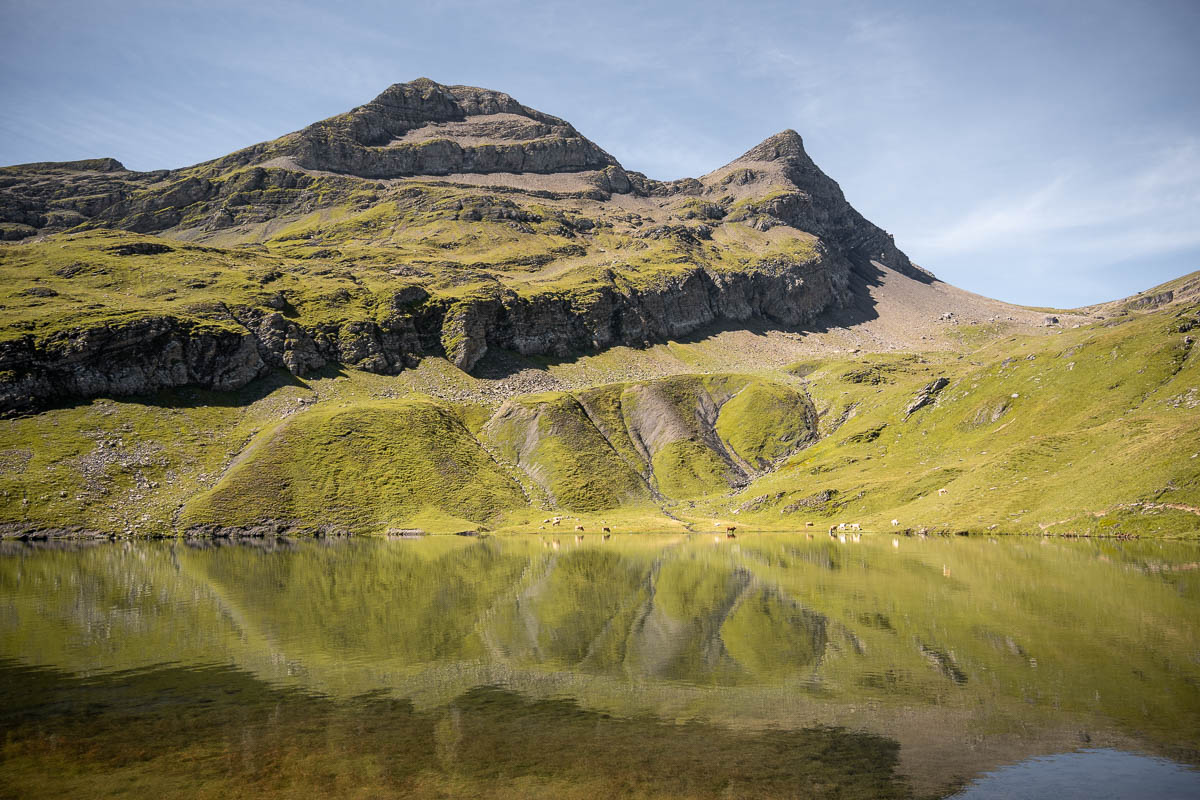
- Another option is to visit the second (lesser known) lake up here: Hagelsee. Just before you reach Bachalpsee you’ll see a sign pointing in the direction of this lake. From there it’s another 40 minutes walking to Hagelsee.
- Go paragliding. All the paragliders gather on the top of Grindelwald First to take you down the mountain while gliding through the air. If you’re not scared of heights, I really recommend it! I paid 210 CHF for a tandem flight of 20 minutes with Paragliding Jungfrau and found it totally worth it. During the flight, your instructor will take pictures and videos with a GoPro which you can purchase afterwards for an extra 40 CHF. Not cheap for a souvenir, but for me it was worth the price. Make sure to reserve a timeslot for your flight well in advance!
- Other adrenaline activities. On top of Grindelwald First, many other adventurous activities can be planned. There is the First Flyer, a zipline, the First Glider, which lets you glide down a zipline from an eagle’s perspective, and can you rent mountain carts or Trottibikes to ride down the mountain.
Restaurant tip: a friendly Swiss man who has been coming on holidays to Grindelwald for over 50 years, invited me to go for dinner at the restaurant of the Eiger Mountain & Soul Resort. They have a lovely terrace with a view and serve traditional Swiss dishes like fondue. I loved the fondue and would highly recommend it!
Day 4: Grindelwald
The second must-visit in the Grindelwald region is the Jungfraujoch, also called the Top of Europe. A train will take you up to the highest train station in the Alps to see the largest Glacier in the Swiss Alps: the Aleitsch Glacier. From here, you’ll have the most stunning view of the Glacier and the eternal ice up the tops. Without a doubt worth a visit, so let me show you how!
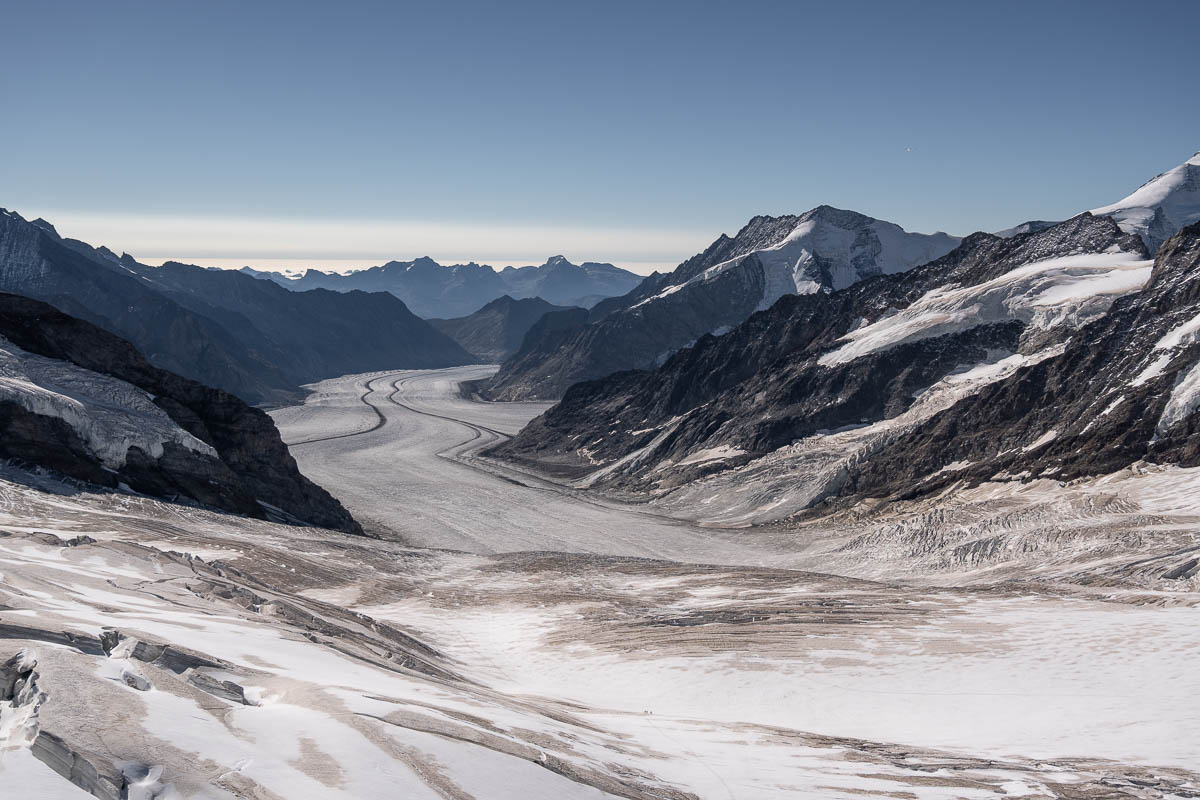
How to get to Jungfraujoch?
If you stay in Grindelwald like I did, then you want to depart from Grindelwald Terminal. Here, the Eiger Express is the fastest way to get you up quickly. In 15 minutes you’ll be up at the Eiger Glacier Station. From here, you take the train all the way up to Jungfraujoch. This will take another 30 minutes. Count approximately 1 hour for the total journey.
Tip: book a seat reservation on the Eiger Express and the Jungfrau Railway. This is an extra reservation on top of the ticket you’re already buying. The benefit of a seat reservation is that you’ll have a guaranteed seat on the lift & train of your timeslot. If you don’t have such a reservation and it’s very busy then people with a reservation will have priority, which means that everyone without a seat reservation will have to wait for the next train. And this one might also be full.
When I visited in early September, a seat reservation was not necessary, but I do recommend it in peak season. Of course, the disadvantage of such a seat reservation is that you’re bound to a specific time and don’t have a lot of flexibility. That’s why I didn’t buy a seat reservation.
An alternative to the Eiger Express is taking the train to Kleine Scheidegg and changing to the Jungfrau Railway there. The train is a little bit slower but offers you a beautiful view! I personally went up with the Eiger Express and down with the train, a perfect combo!
Tip: make sure to sit on the right side going up by train and the left side going down.
What to see at Jungfraujoch?
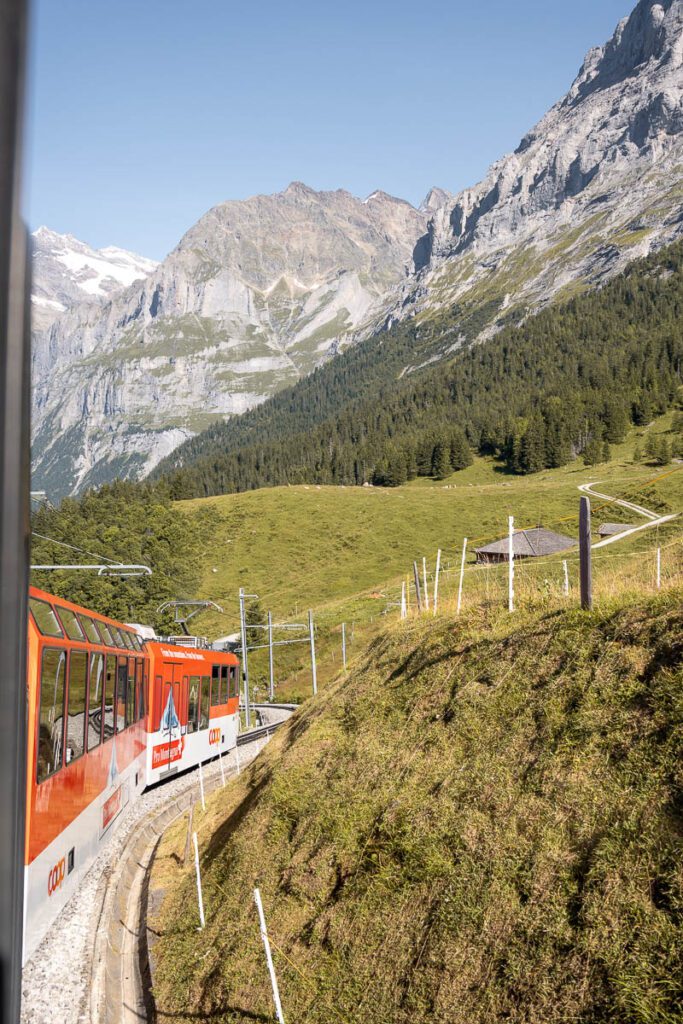
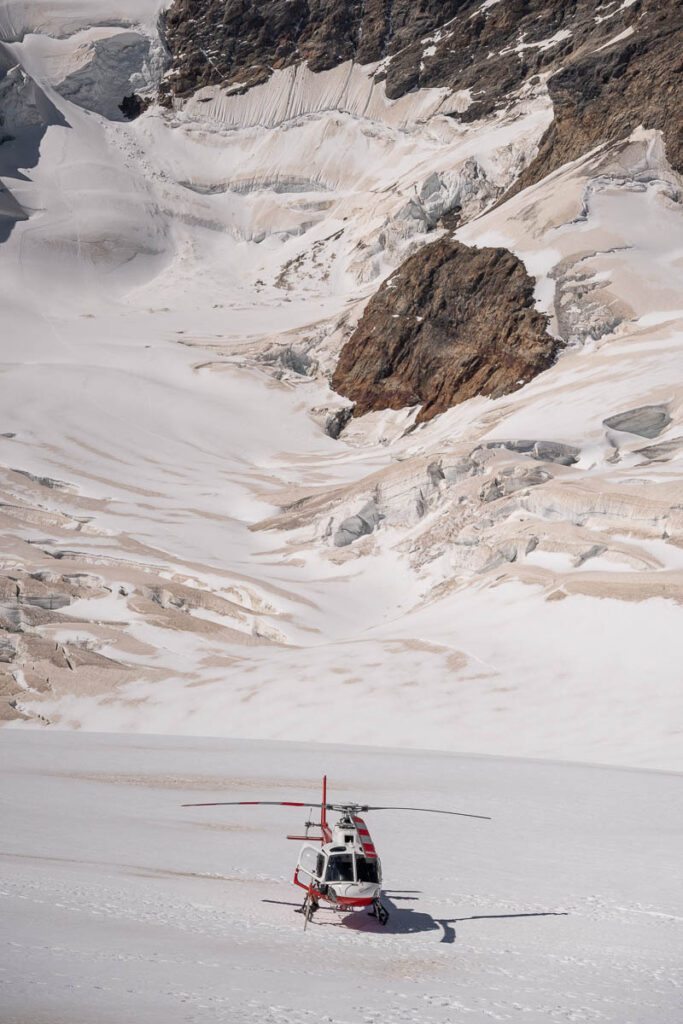
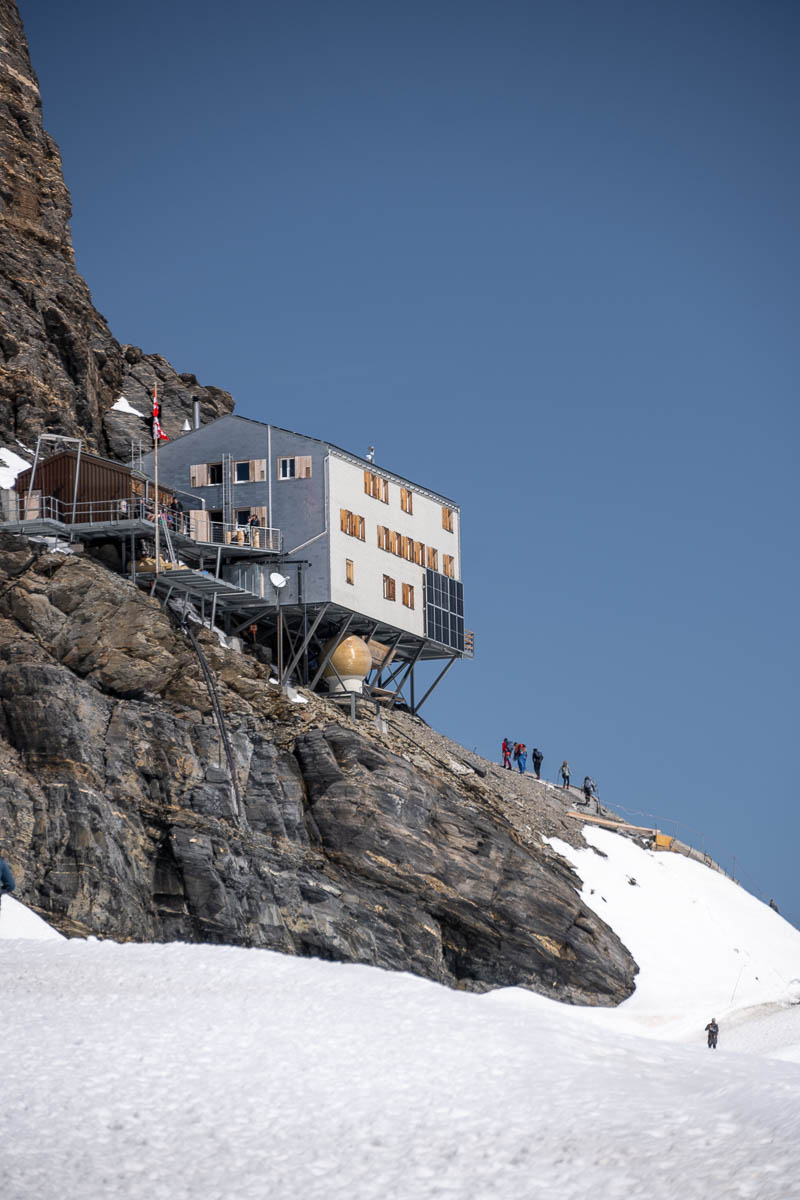
The entire Jungfraujoch is basically a round tour you do with lots of experiences along the way. Even before arriving at the Jungfraujoch, you have your first experience, because the Jungfrau Railway will stop for 5 minutes at Eismeer Station, an underground viewpoint where you can get a first glimpse of the glacier.
When arriving at the Jungfraujoch itself you’ll be guided through a 360° multimedia experience with wonderful images of the glacier and Jungfrau up close. Then you’ll proceed to the lift that takes you to the Sphinx Platform, the highest viewpoint on the mountain from where you’ll have a stunning view of the Aletsch Glacier, definitely a highlight!
The tour continues back down with an Alpine Sensation, where you’ll learn more about the history of the peak and the first people exploring this place. Afterward, you’ll pass through the Ice Palace, a cave made entirely of ice where you can admire some beautiful ice sculptures.
Continuing there’s another viewpoint called the Glacier Plateau where you’ll stand next to the Jungfrau top. Last but not least you’ll be guided to the restaurants and shops, where you can buy some chocolate in the highest Lindt shop in the world or spend your money on some luxury Swiss items.
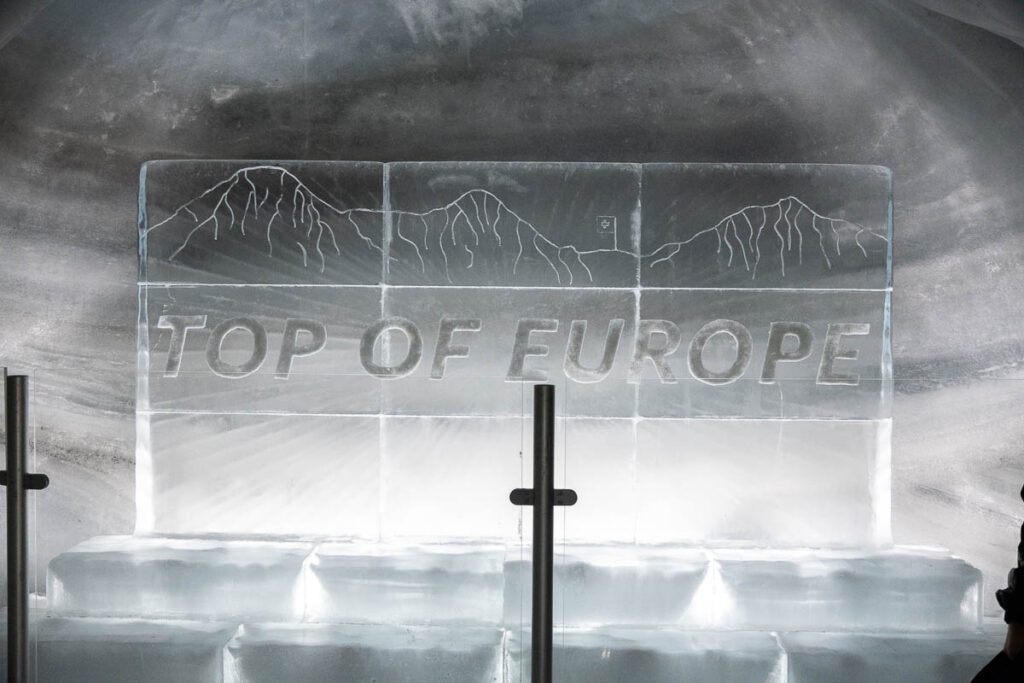
For me, 3 activities were worth it:
View of the Aletsch Glacier
The view of the Aletsch Glacier from the Sphinx Platform was definitely a highlight for me. It’s just so impressive to see the glacier laid out in front of you! The most stunning pictures are also taken here, although the light can be very sharp during the day.
The Ice Palace
I’ve never been in a cave entirely made of ice so this was super cool to see! It takes only 5 minutes to go through but it’s definitely fun.
Hiking to the Mönchsjochhütte
The activity I loved the most. In 50 minutes you can hike from Jungfraujoch to the Mönchsjochhütte over the glacier. Don’t underestimate this hike because walking over snow and ice is harder than you can imagine! Also, make sure to wear proper clothes and shoes, the wind can be vicious and the road slippery.
At the hut, you’ll be asked to take off your shoes and change into (absolutely not) fashionable slippers. On the terrace, you can again enjoy the view and inside you can enjoy a delicious hot meal for a reasonable price (I was surprised, the wine was more expensive than the food…). I took a portion of raclette and homemade soup, it was delicious! If I didn’t need to go back I could have sat there for hours with a hot cup of chocolate looking at the glacier.
Fun fact: you can actually stay the night at the hut! If you’re in for some adventure, go ahead and book the night here. I can imagine that sunrise and sunset at 3500 meters altitude must be magical!
Disclaimer: Jungfraujoch is quite a touristy activity and it can get very busy. Try to visit early in the day. If you do so you might benefit from the Good Morning Ticket, where you enjoy a discount for visiting early!
Restaurant tip: I went eating again at Hotel Restaurant Alte Post, because a lot of restaurants were closed on Tuesdays. If not, I would have tried Restaurant Pinte on the recommendation of my new Swiss friend. Another place I didn’t get to try is (what seems to be) the only bar in town, Avocado Bar. It looked like a great place to have a drink so I’m sad I didn’t get to try it.
Day 5: Grindelwald – Lauterbrunnen – Kandersteg
On my fifth day in Switzerland, it was time to say goodbye to Grindelwald because I wanted to check what the hype of Lauterbrunnen was all about. I’m sure you must have seen that one perfect image of the town with the waterfall falling down and the picturesque little church. But is it as beautiful as the picture?
It took me about 40 minutes to get from Lauterbrunnen to Grindelwald (changing trains in Zweilütschinen). Here I left my luggage at the train station again. But this time the lockers were too small for my suitcase. Luckily I could leave it in a separate room at the info desk of the station for only 5 CHF.
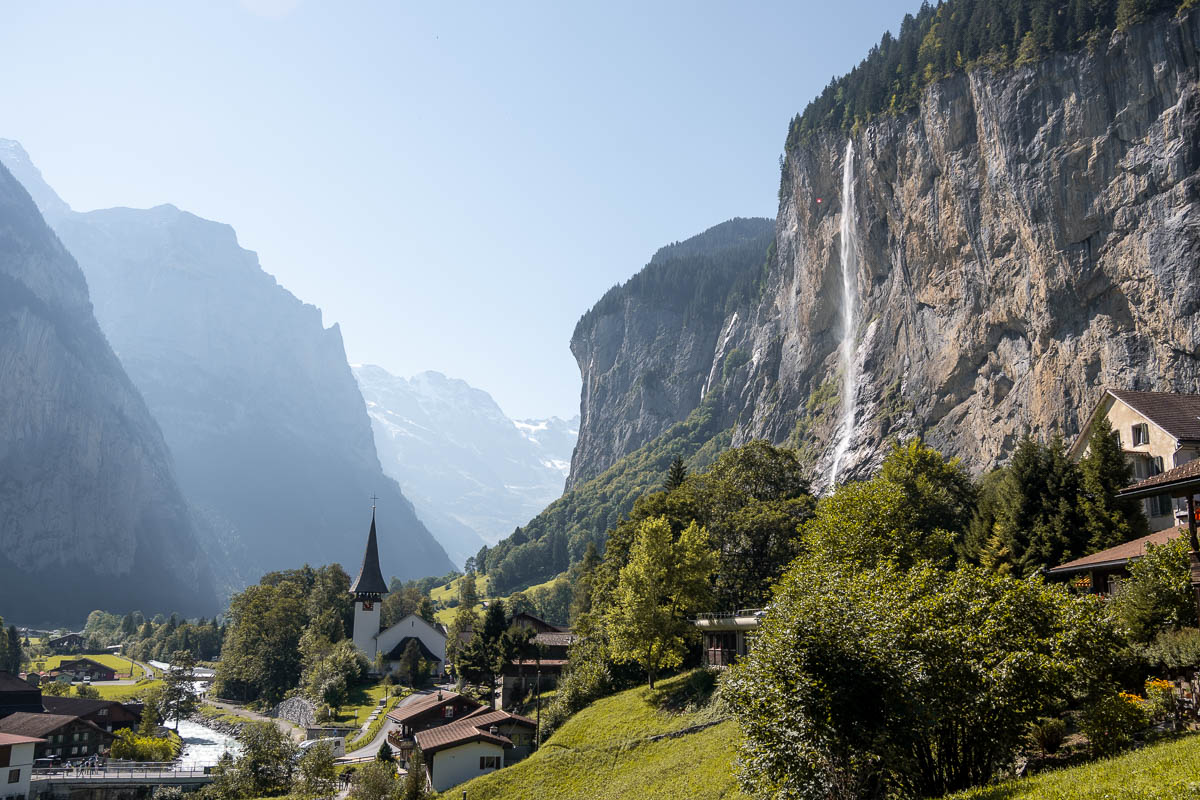
From there I walked through the town, stopping at the tourist info point to get a brochure, and continued exploring the town on foot. What I immediately noticed is that Lauterbrunnen is very touristic, even worse than Grindelwald. Although the town itself is very cute, the many tourists, shops, and cheap food stands take away a lot of the charm of the village. So you might notice that I was a bit disappointed by my visit.
Of course, I had to visit the famous photo spot here, you know, the one you see floating all over the internet. However, I left after 1 minute because I didn’t feel like standing in line for a picture. To be honest, the lighting wasn’t good as well. If you want a perfect picture, you should go early in the morning!
So I went to visit Lauterbrunnen’s famous waterfall, you can go up a staircase to come close to the water, and then quickly escaped the town. Every half hour you have buses taking you deeper into the valley, and that’s a must! Here are some other things you should have seen around Lauterbrunnen:
- Trümmelbach Falls: the only underground glacier waterfalls in Europe that you can also visit! For 14 CHF you can go underground to see how the water has paved its way.
- Schilthorn: this peek is mainly known as the filming location of the James Bond film ‘In Her Majesty’s Secret Service’ that was recorded here in 1969. On top, you’ll find a rotating restaurant and several James Bond attractions such as the ‘Bond World’ or the ‘007 Walk of Fame’. From Lauterbrunnen, you’ll need to take the bus to Schilthorn and then take a cable car up.
- Hiking in Mürren or Männlichen: many impressive hiking trails are available in the region. The most popular hiking spots are Mürren and Männlichen where you’ll find various hikes with stunning views.
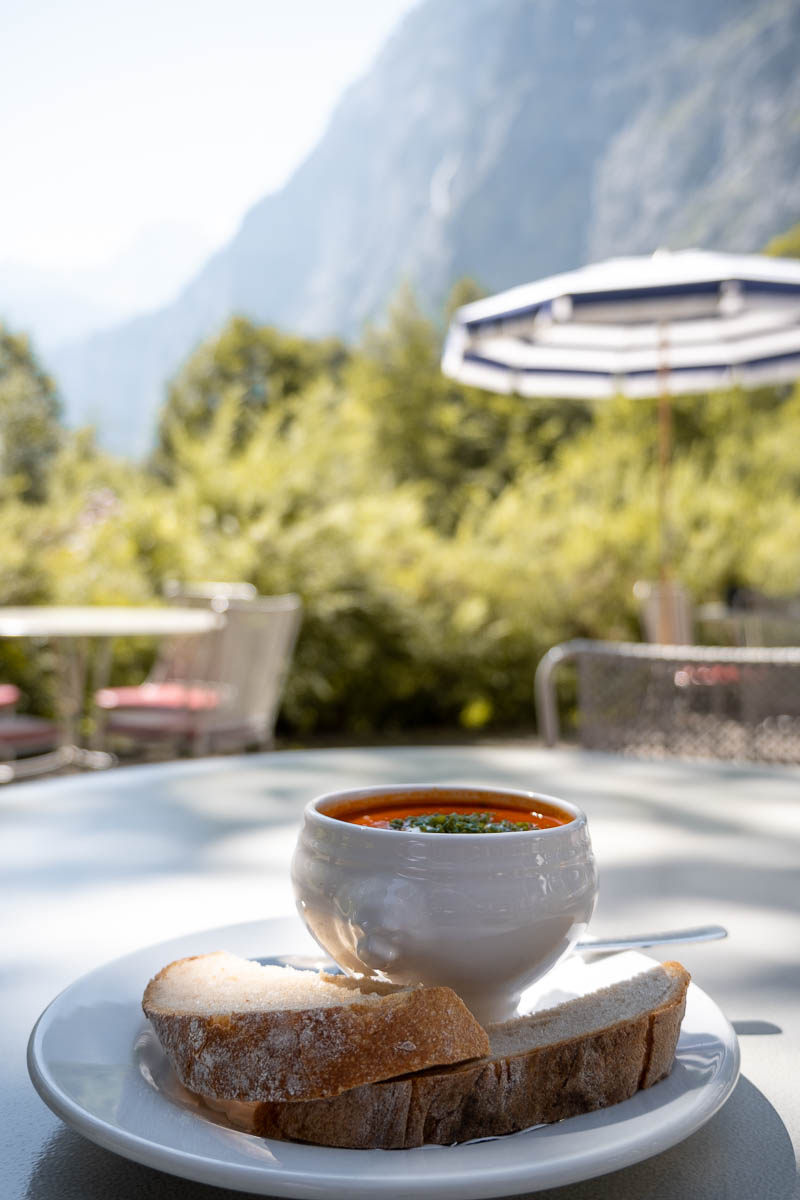
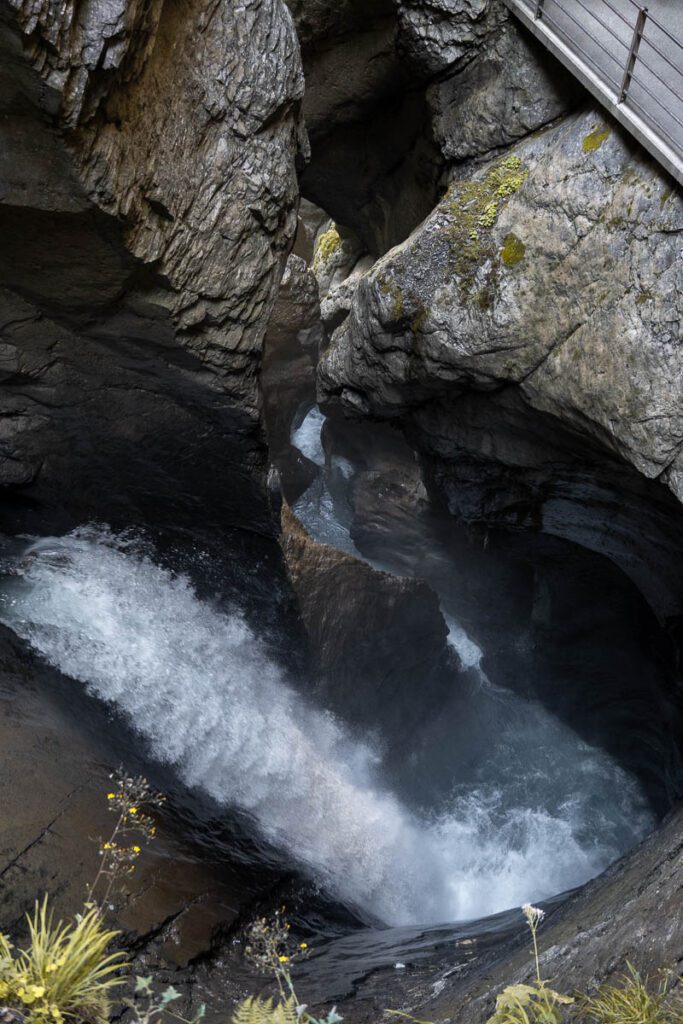
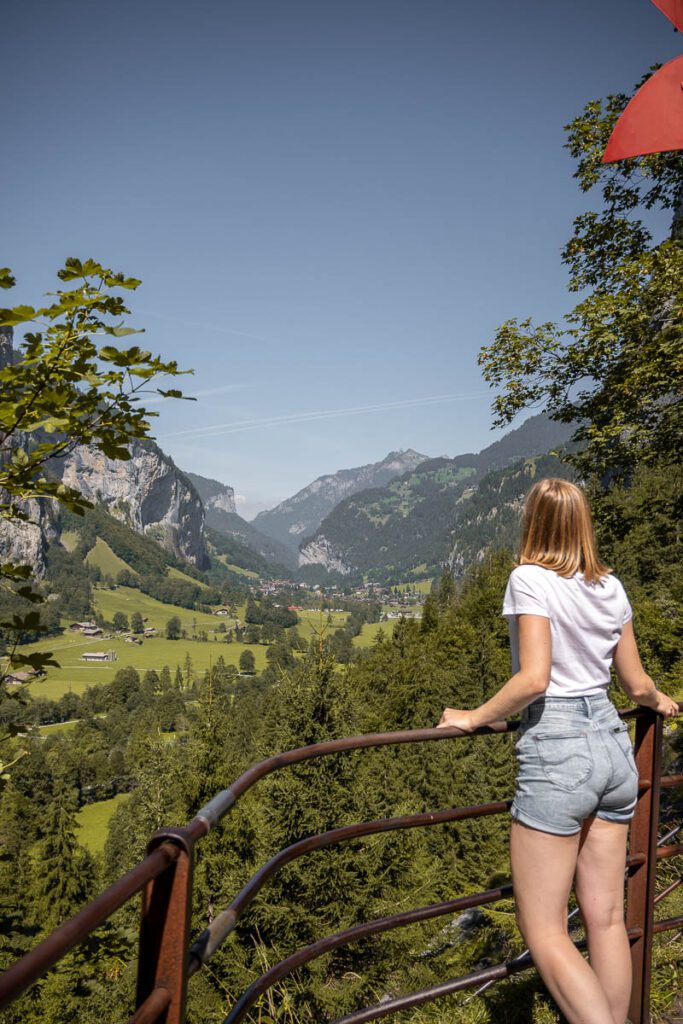
Tip: you can download the Lauterbrunnen photo hotspot trail from the tourism office that takes you past 8 stunning photo spots in the village of Lauterbrunnen.
After my visit to Lauterbrunnen, I picked up my luggage at the train station and hopped on a train to Kandersteg. The connection to Kandersteg isn’t the best from here. I had to take 3 trains (Lauterbrunnen – Interlaken Ost – Spiez – Kandersteg) to eventually arrive in the village. But what a relief compared to Lauterbrunnen! Although many tourists come hiking here at Oeschinensee, it is not nearly as touristic and the village still feels authentic.
Hotel & restaurant tip: I checked into Chalet Hotel Adler, a beautiful 3-star hotel that has rooms with balconies facing the mountains. Moreover, they have a spa available and their breakfast is delicious! Also, their restaurant serves delicious Italian food, which is of course what I tried that night.
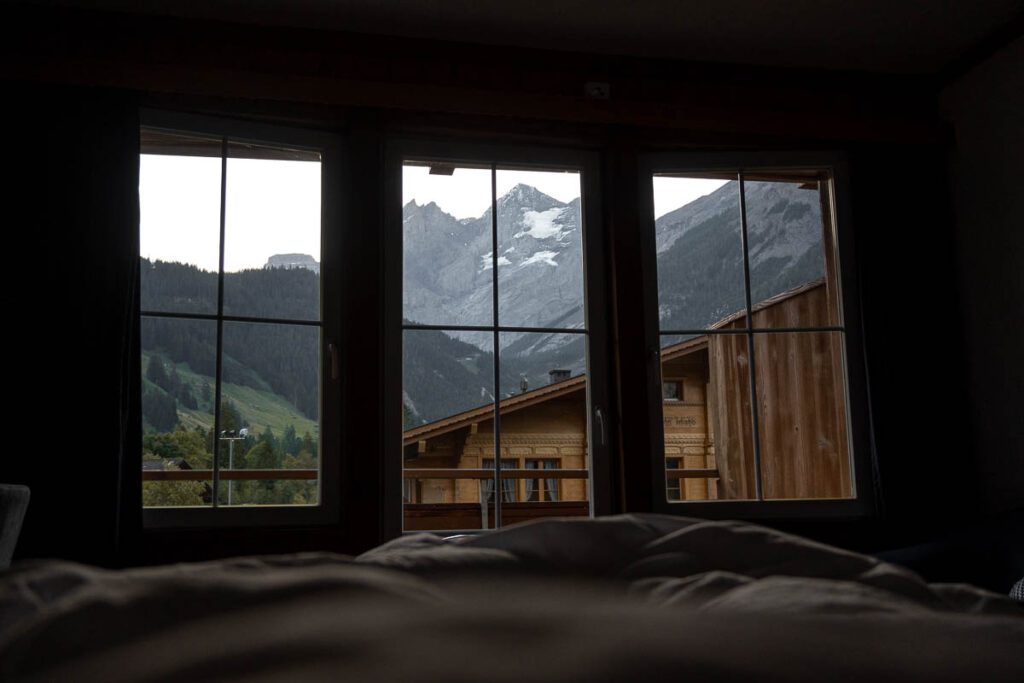
Day 6: Kandersteg – Zermatt
My day in Kandersteg was undoubtedly one of the highlights of my 2-week Switzerland trip. Why? Because here you can go hiking around the stunning Oeschinen lake! You cannot see the lake from the village below as it’s conveniently hidden in between the mountains. These days, people come from far away by train to go hiking here.
How to get to Oeschinensee
Pass by the tourism office to get a map of the hiking trails in the region and make your way to the Oeschinensee cable car. This cable car will take you up to the start of all the hiking trails around Oeschinensee. And even if you don’t feel like a challenge you can just go up for the views and take an easy walk to the lake to go swimming or chilling.
You can easily buy your ticket at one of the ticket boots there but if you want to save time you can also buy it online beforehand. A retour ticket costs 30 CHF which is super affordable compared to other popular cable cars. And if you have the Swiss Travel Pass like me it just costs you half the price.
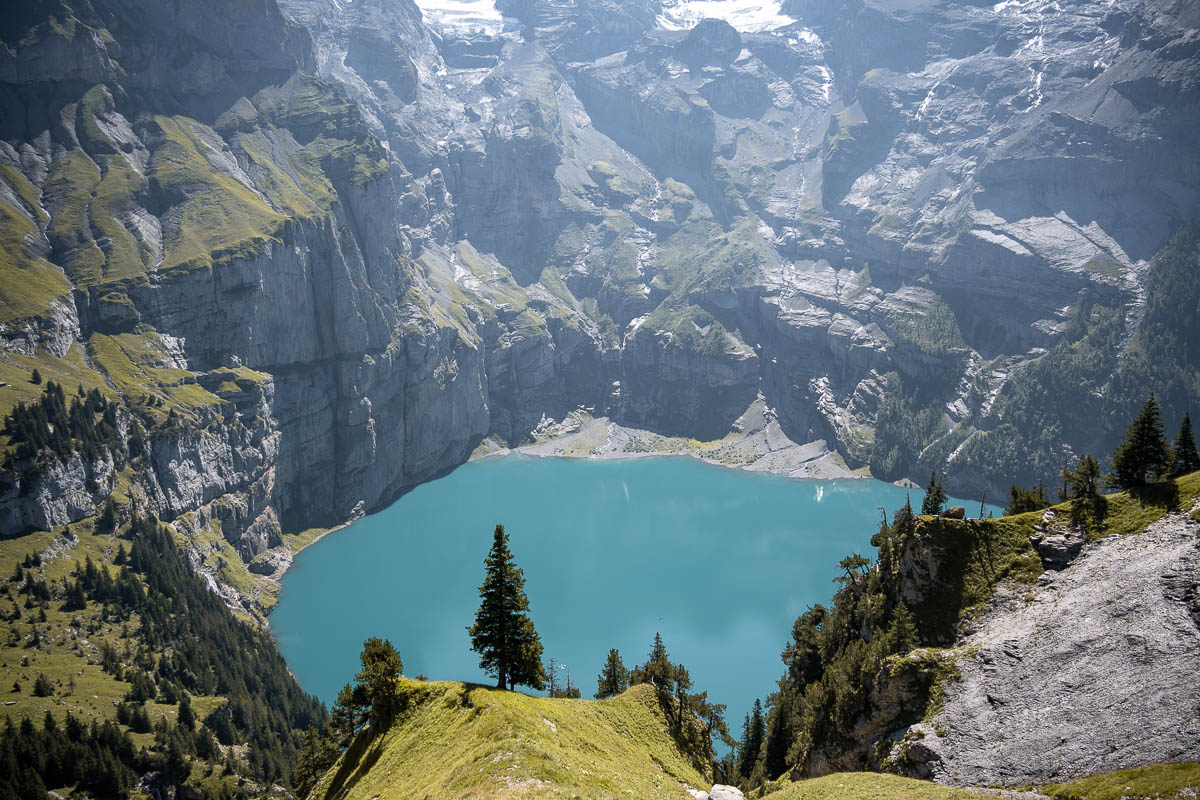
What to do at Oeschinensee
Once you got up by cable car you can start onto one of the trails around the lake. If you’re not up for a challenge you can just take route 5 or 4 in the direction of the lake, but if you do like a challenge then you can go for a 4-hour roundtrip with stunning views of the lake.
For this roundtrip, start taking trail 5 and then 8. It will be a lot of climbing in the beginning, but once you’ve gained that altitude you’ll be treated to amazing views of the lake and the hike will become much easier. Once you’ve reached the Oberbärgli, a mountain hut where you can stop for a drink and snack (cash only!), you’ll start to descend until you walk alongside the water. The descent is a slippery road with lots of stones so make sure to wear sturdy hiking boots and bring hiking poles if possible. You should also not be afraid of cows because these just roam freely on the way down!
Make sure to start the hike by going up so that you can do the most difficult part first. The other way around (trail 5 – 6 – 8) would definitely be more exhausting. Plus, if you start left, you can relax with your feet in the water at the end. A welcome ending to an exhausting hike!
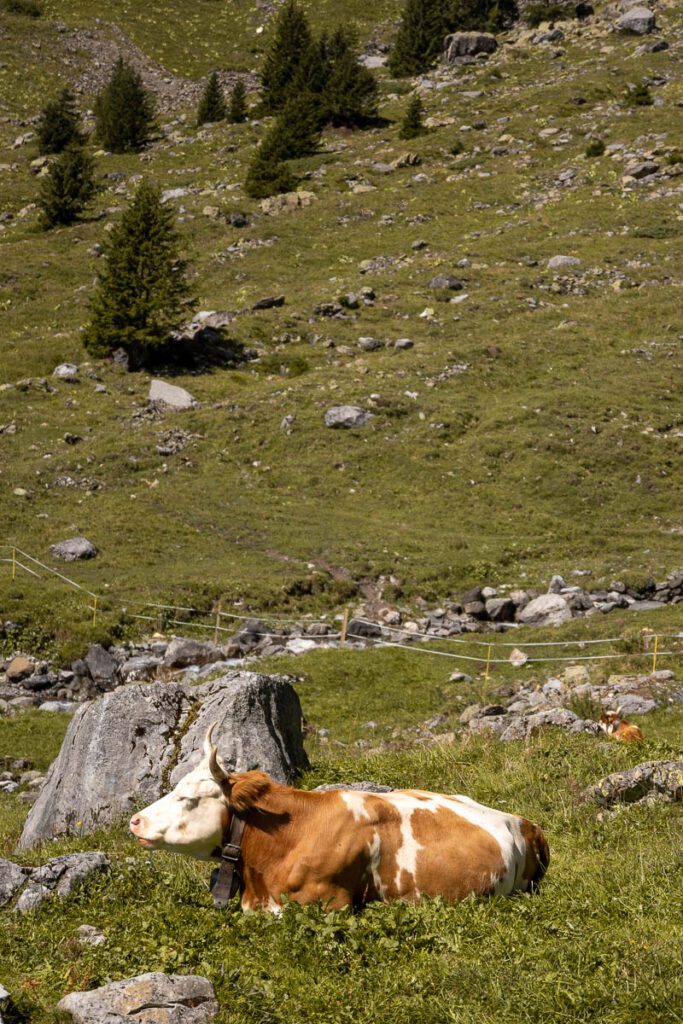
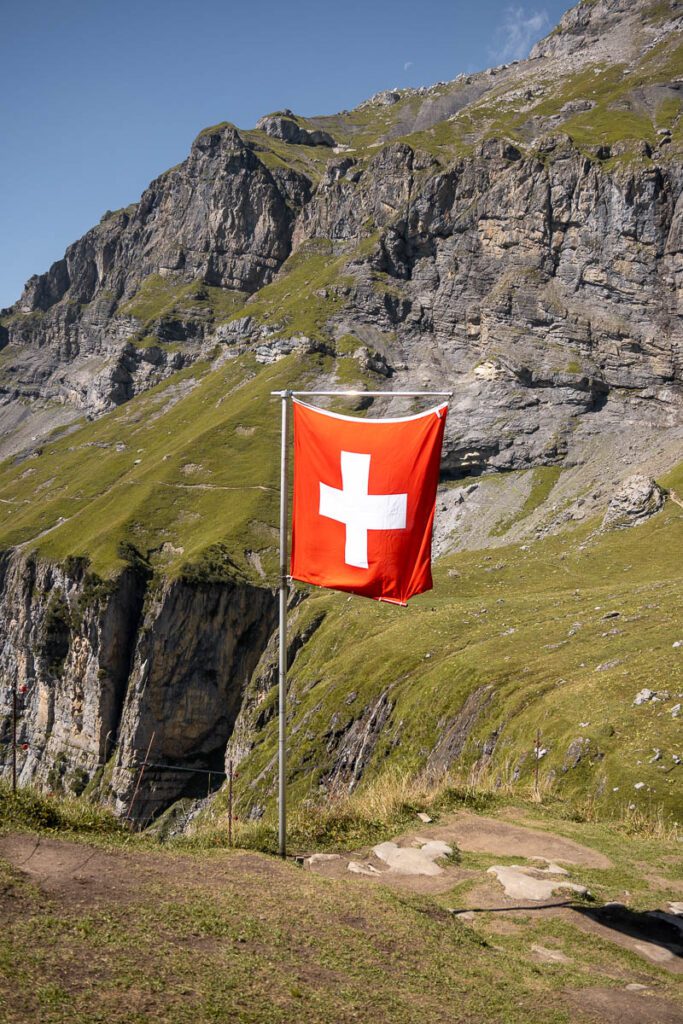
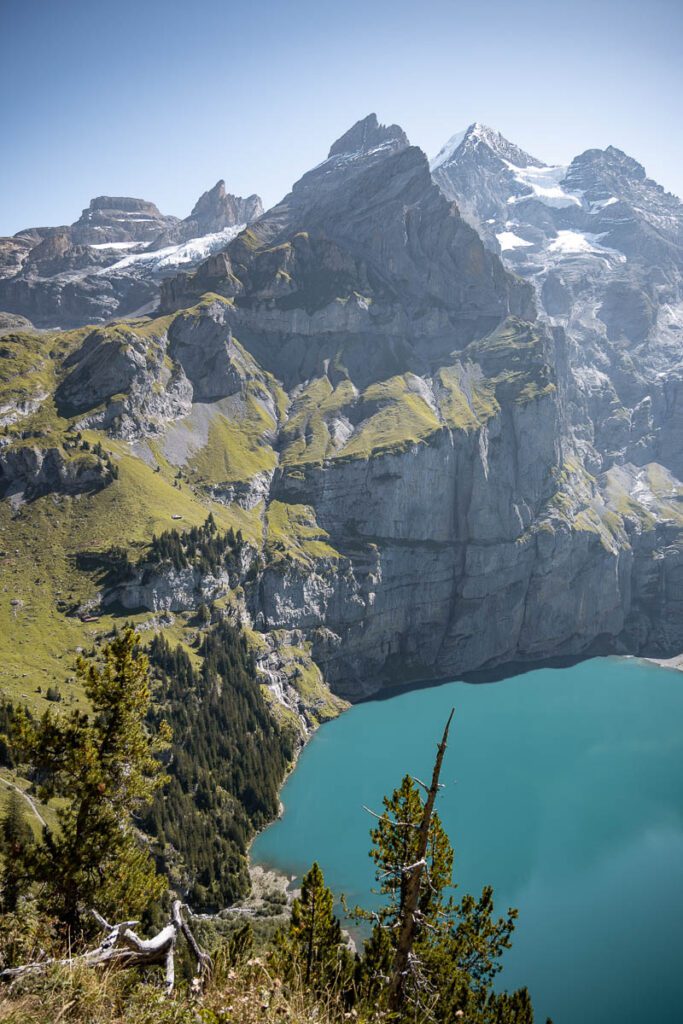
Here are some other things to do while you’re here:
- Go all the way up to the Blüemlisalphütte. This takes you about 6h30 starting at Oeschinensee. It’s only for experienced hikers and if you wish you can also stay the night here.
- Bring your swimsuit and go swimming! But be aware that the water is ice cold so don’t just jump in.
- Rent a rowing boat and explore the lake. I’ve seen them row from above and it looked so romantic!
- Bring your own picnic and go barbecuing alongside the lake. No better spot to spend a nice afternoon with friends!
Heading to Zermatt
I started hiking Oeschinensee at 10:00 in the morning and was finished (including the necessary photo and toe dipping stops) near 15:00. After that I went to pick up my luggage at the hotel and took the train to Zermatt. This was another 2-hour train ride with a change of trains in Brig (or Visp).
Hotel tip: once in Zermatt I checked into Hotel Chesa Valese and god, it was the best hotel stay of my entire trip in Switzerland! This 4-star hotel doesn’t only look cute, the staff is beyond helpful and their service is excellent, especially for the price you’re paying! For example, upon leaving the lady at the front desk offered to call me a taxi to the station (free of charge) and gave me a goodbye bag with some delicious Swiss chocolate. There’s a pillow menu you can choose from, their breakfast buffet is extensive and healthy, and the wellness after a long day of hiking is wonderful. If there’s one hotel you need to spend your money on, it’s this one. 😉
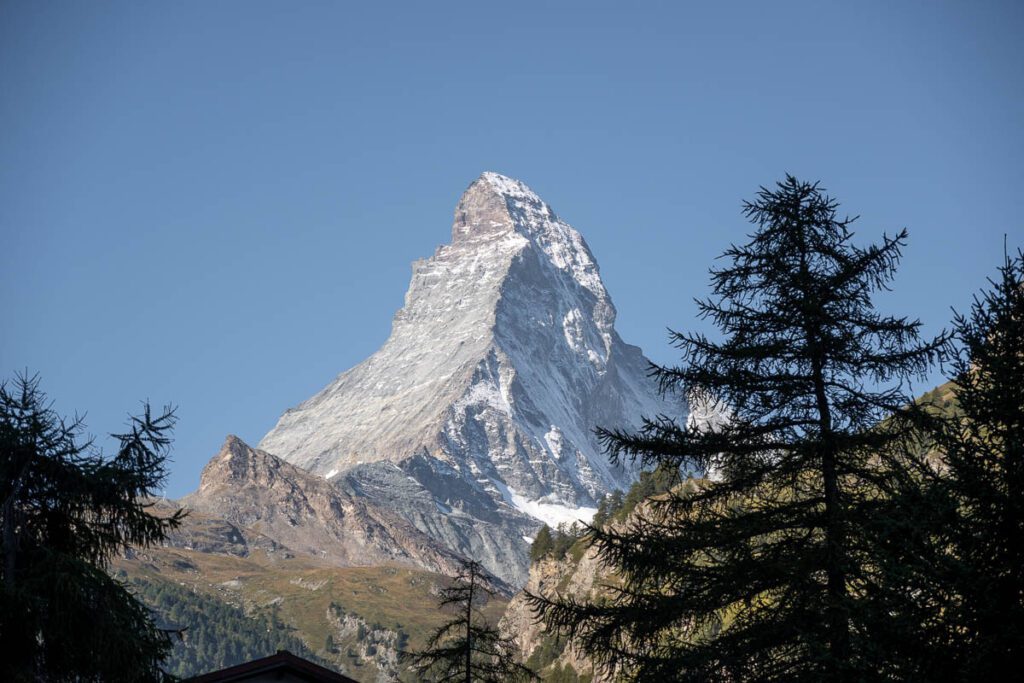
Things to know about Zermatt before you visit
First of all, Zermatt is not a small cute mountain village where only locals live (yes, I met an Australian hiker who was very confused about this, quite funny to see). So if you’re not from Europe let’s set the expectations right. Zermatt is a luxury ski resort where (generally speaking) the wealthier people go skiing in winter. Hence don’t be surprised to see that prices are a little bit more elevated here (especially at restaurants).
Second, Zermatt is car-free, which means all visitors need to leave their cars in Täsch and take a train to Zermatt. Traveling here by public transport is thus really the most convenient option! However, you will see a lot of small electric cars driving around. These are either taxis or hotel shuttles so you should still watch out when crossing the street!
Day 7: Zermatt
Just like in Grindelwald, there are 2 non-negotiable activities in Zermatt. The first one is visiting the Matterhorn Glacier Paradise. The second one is going up Gornergrat. If you only have time for one, please choose the Matterhorn Glacier Paradise! That’s also the activity I started with.
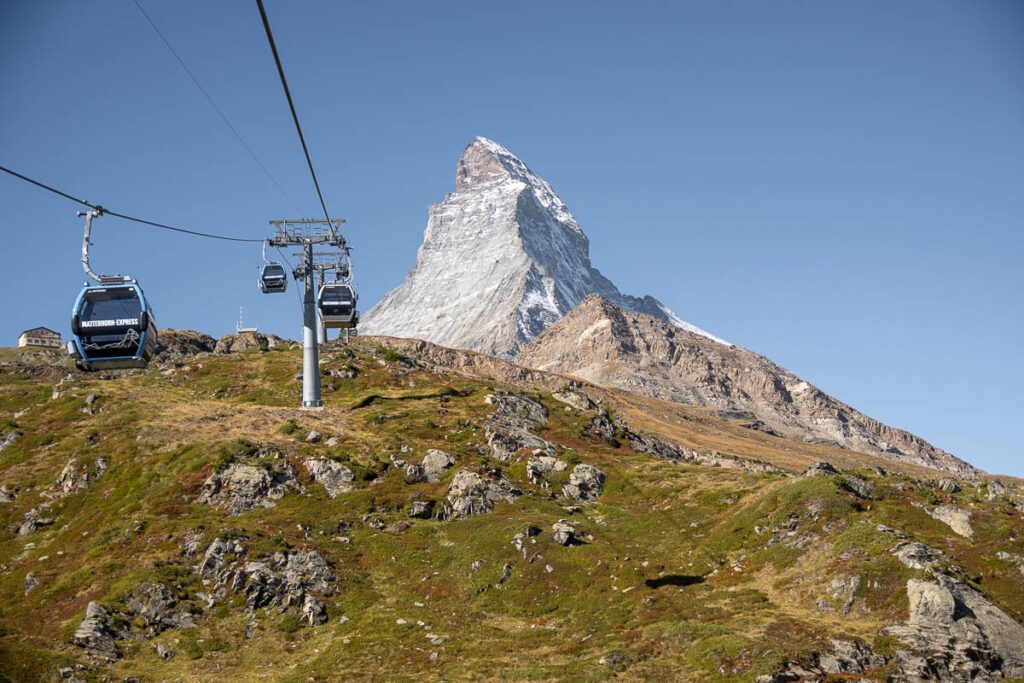
How to visit the Matterhorn Glacier Paradise
The Matterhorn Glacier Paradise is the highest mountain station in Europe at 3.883 meters above sea level. From the peak, you have a stunning 360° view of the surrounding mountains and valleys. As it’s eternally covered in ice and snow, people are skiing here year-round, and national ski teams from all over Europe practice here daily.
It took me a while to figure out which cable car to take where in Zermatt to get up the Matterhorn Glacier Paradise. But in fact, it’s not difficult as there are only 2 cable cars in town. First of all, make sure to get yourself a map of the region with all the hiking trails and cable cars. Usually, your hotel will have these maps at the reception.
You can go up by taking the cable car at the Zermatt cable car station on the outskirts of the town. From the town center, it’s a 10-15 minute walk. Take this cable car all the way up. Remain seated at the stops of Furi and Schwarzee, and get out at Trockener Stegg. Here you can take the Matterhorn Glacier Ride up to the Matterhorn Glacier Paradise.
Tip: quickly get out at Schwarzee to take a picture of the lake, in the morning you have the best light and reflections from the Matterhorn!
The Matterhorn Glacier Ride is one of the most impressive cable cars in Europe with a stunning view of the glacier you’ll hang over on your way to the top. If you really want a cool experience, go buy an upgrade for the Crystal ride. In these special gondolas, part of the floor is made of Swarovski crystals which will become opaque after a few minutes into the ride so you can watch the glacier through the floor. This was beyond impressive to see!
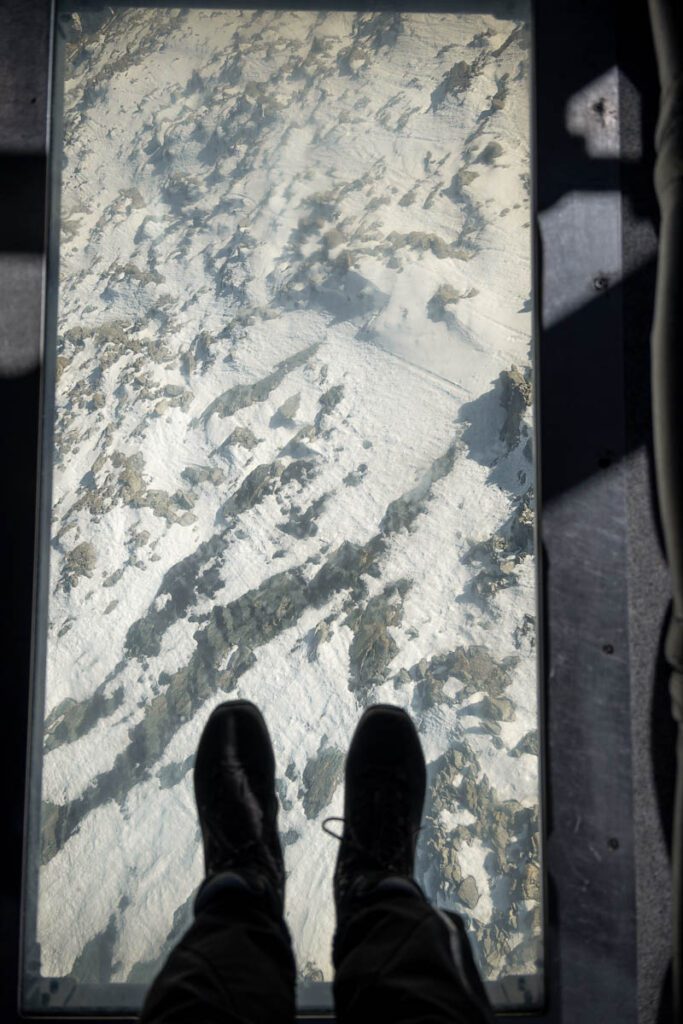
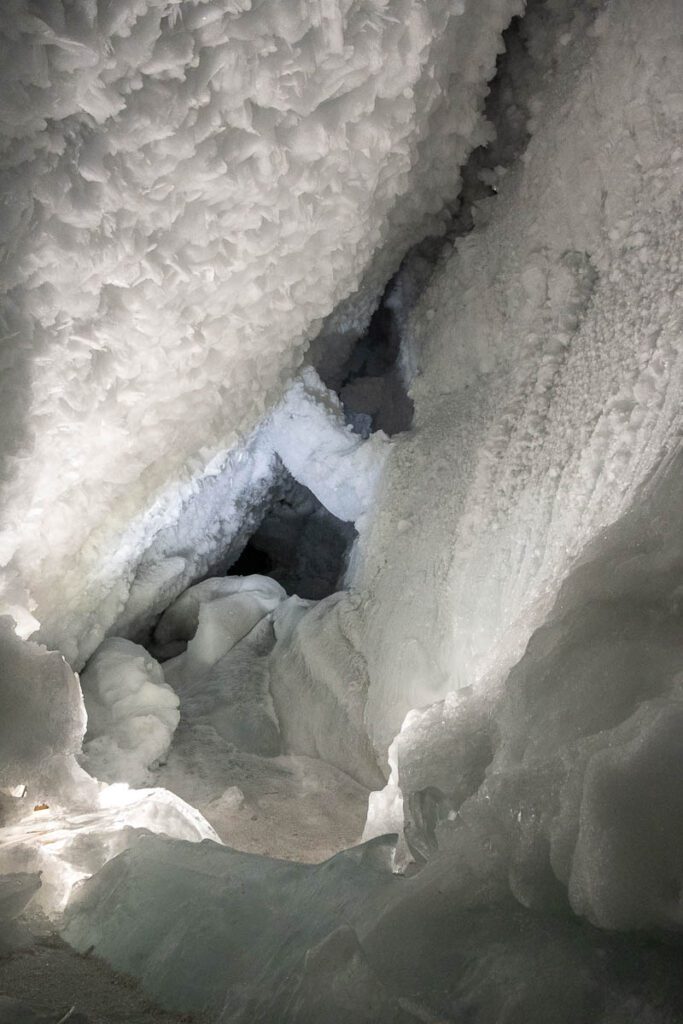
Once you’ve arrived at the top, there are a few things you should do:
- Watch the 360° view from the observatory platform. The view of the Matterhorn and surrounding peaks and glaciers is stunning!
- Visit the Glacier Palace. Just like at the Jungfraujoch, there’s an ice palace here. However, I found the one in Zermatt much more impressive! Here you literally enter a glacier where you can see a real crevasse, beautiful ice sculptures and you can even slide down an ice toboggan. (Yes, I tried that, it was fun. ;))
- Visit the Cinema Lounge to watch wonderful images of the glaciers and Matterhorn up close.
- Go skiing! Rent your skis in the village of Zermatt, buy a ski pass, and enjoy the slopes, even in summer!
- Visit Italy. From the Matterhorn Glacier Paradise, you can take a cable car to the side of Italy, which is just across the mountain.
- Have lunch with a view at the self-service restaurant. I wasn’t blown away by the food, but they have some local specialties like rösti, käseschnitten, and käse-spätzli.
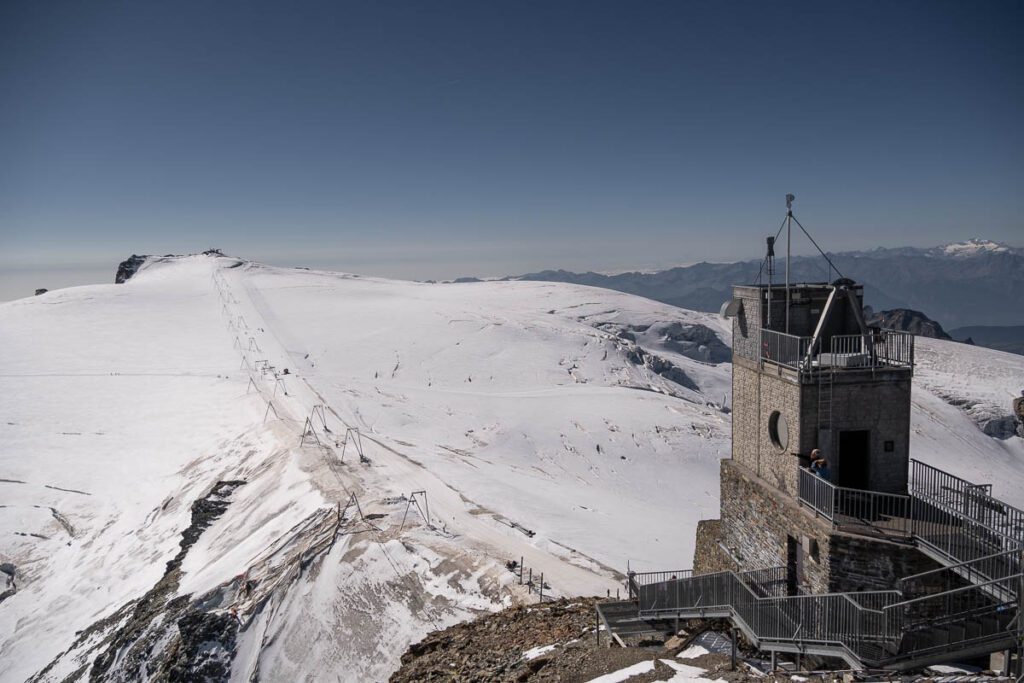
Warning: the elevation of the Matterhorn Glacier Paradise is so high that you might experience altitude sickness. It is recommended to move slowly and take it easy up there. I personnally experienced some dizziness and an uncomfortable feeling. This uncomfortable feeling went away when taking the cable car back down to Trockener Stegg.
Matterhorn Glacier Trail
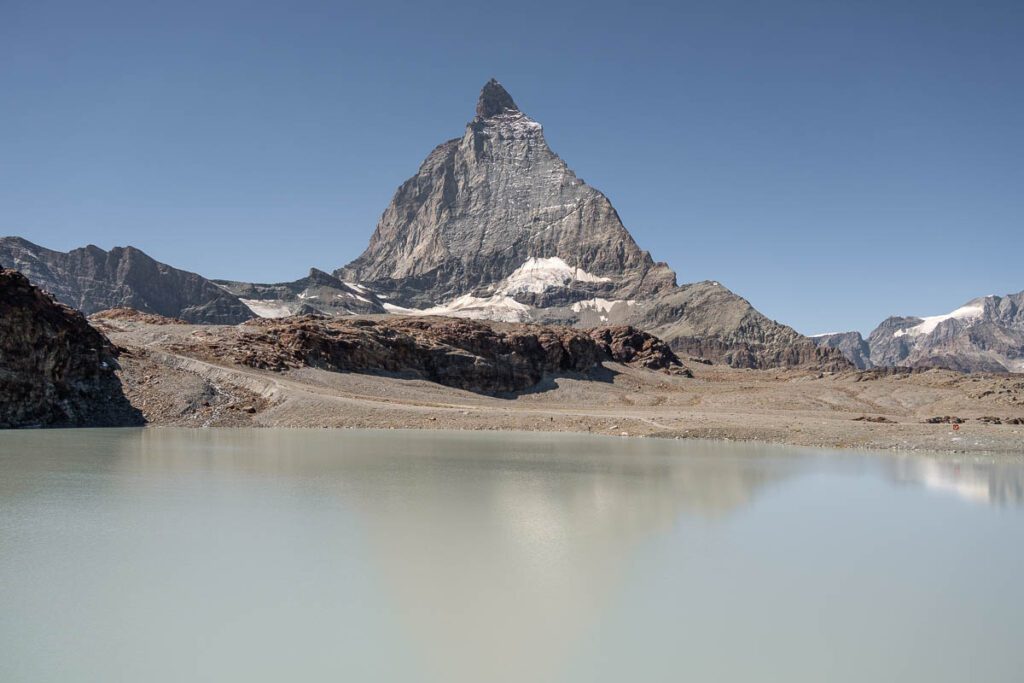
At Trockener Stegg you can start one of the most impressive hikes around the Matterhorn, called the Matterhorn Glacier Trial. This 2-hour hike (6.6 km) takes you literally around the peak in a moonlike landscape where several glaciers used to run. Right now a lot of glaciers have retreated and a rocky landscape with rivers of glacier water remains.
The hike starts at Trockener Stegg and goes down to Schwarzee where you can take the cable car down. Of course, you can also do it the other way around, start at Schwarzee and hike up but this will take you longer than 2 hours. Make sure to wear sturdy shoes as the rocks can be a bit tricky. During the hike, you’ll be able to take the most stunning pictures of the Matterhorn!
Tip: take a good look at the opening hours of the cable car because you don’t want to arrive from an exhausting hike and see that the cable car closed already! Usually, they close around 16:00-16:30.
Back to Zermatt
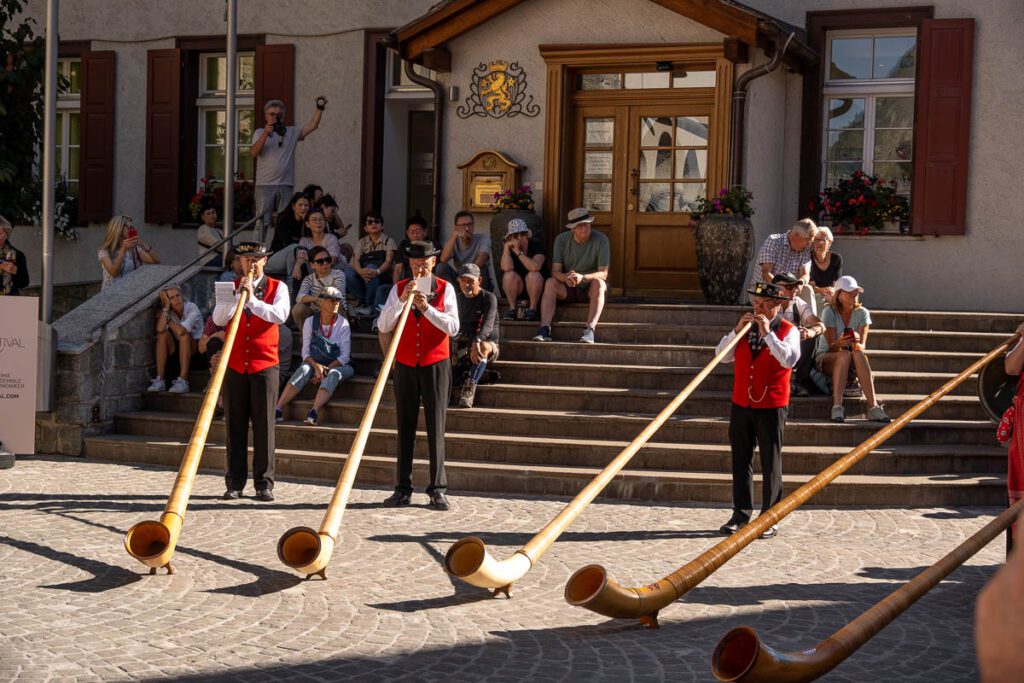
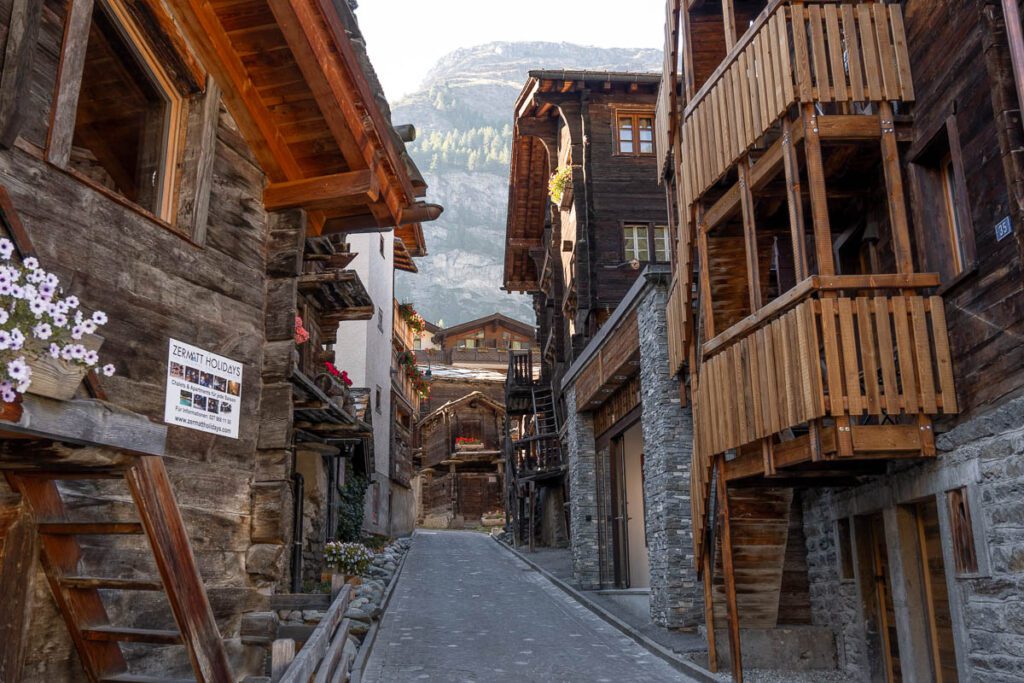
If you arrived back in Zermatt and still have energy you might want to take a look at Zermatlantis, the Matterhorn Museum. It tells you everything about the history of Zermatt and the first successful ascent to the Matterhorn (which also had a tragic ending).
I personally was very tired when coming down so I went straight to my hotel Chesa Valese and checked out their wellness area with sauna and steam bath, highly recommended!
Restaurant tip: that evening, I ate some very delicious (and affordable!) pizza at the North Wall Bar & Restaurant. You can make your own pizza from scratch with all the ingredients you want. It’s a fun place to have a drink as well!
Day 8: Zermatt: Gornergrat
The 2nd must-do activity in Zermatt is going up Gornergrat with the Gornergrat Railway. This iconic red train takes you all the way to 3.089 meters from where you have a stunning view of the Matterhorn and Gornergrat Glacier. The train runs every half an hour and starts on the opposite side of the road at the Zermatt train station.
Tip: go sit on the right side of the train in a seat with a window that can be opened. From this side, you’ll have the most beautiful views and through the open window, you can easily take some pictures! I was able to make the most beautiful pictures between Riffelberg and Gornergrat with the Matterhorn in the background.
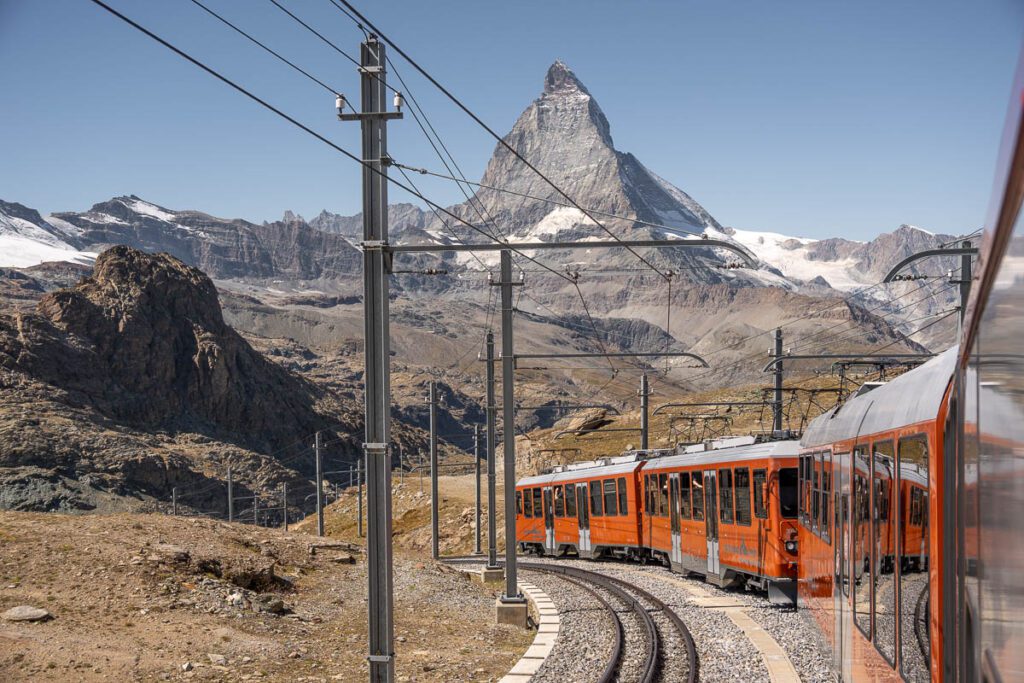
What to do at Gornergrat
Once you’ve arrived at Gornergrat, there are several things you can do. First of all, walk all the way up to the viewpoint. From here you have a magnificent view, super close to the Gorngergrat Glacier, which is the 3rd largest glacier in the Alps, and with the Matterhorn in the background. After the viewpoint, here are the other things you should have seen:
- Walk the 500-meter-long roundtour with panoramic views. It’s an easy walk on the Gornergrat that only takes you 20 minutes.
- Go have a look inside the chapel.
- Visit ZOOOM, a unique experience with a 3D cinema of the Matterhorn up close, a virtual paraglide experience, and more information about the history of the Matterhorn.
- Go shopping. Yes, there are a few souvenir shops located here!
- Have a drink on the terrace with a stunning view.
After you’ve explored the Gornergrat top, it’s time to slowly go down. But not before visiting another highlight on this mountain: Riffelsee. It is one of the most famous lakes in Zermatt so many people will stop here for a picture. For a good reason! The reflection of the Matterhorn is just stunning. You can either take the train down from Gornergrat to Riffelsee or hike it. From Gornergrat to Rotenboden it’s a 40-minute hike. At this stop, you’ll find Riffelsee.
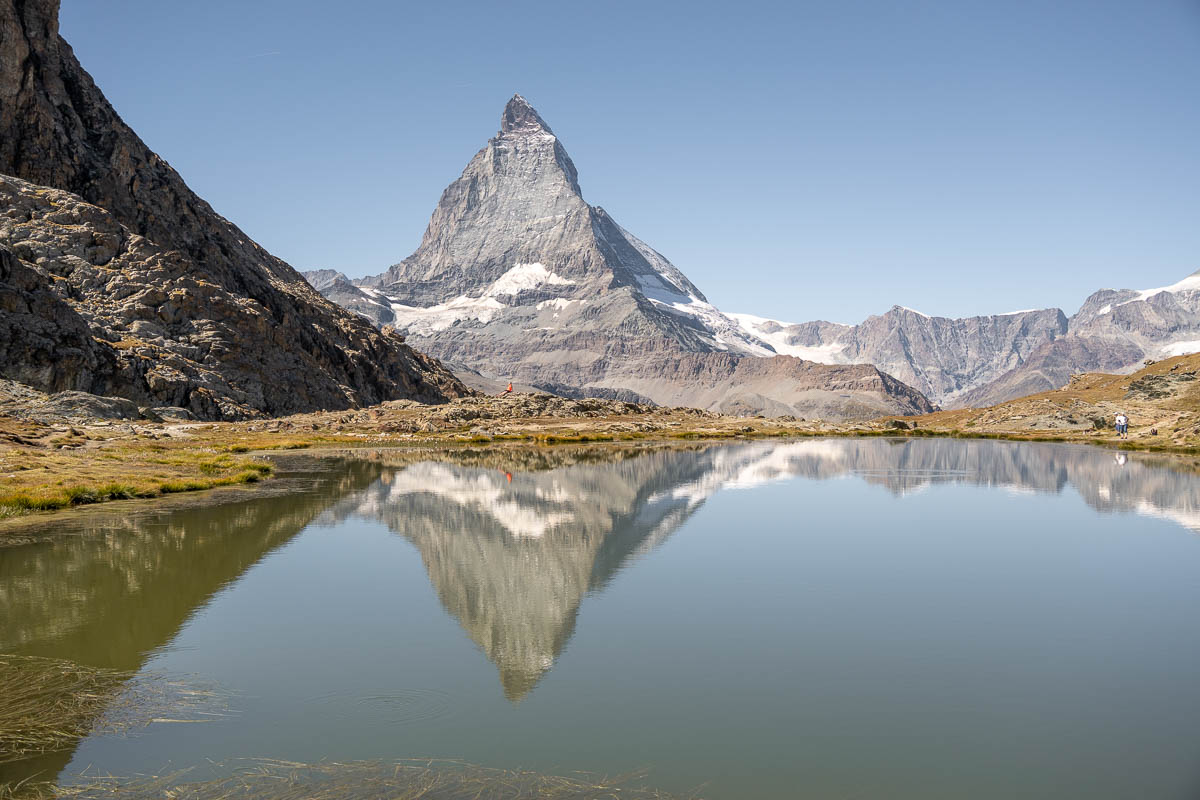
If you feel like doing a longer hike, go all the way down to Riffelberg, which is 1h50 instead of 40 minutes. Of course, you can also just hike all the way down to Furi (another 1h50) and Zermatt. Make sure to get a hiking map at the tourist office to see all the options.
Hiking the 5-Seenweg or 5 Lakes Walk
After seeing Riffelsee I went back down to Zermatt to take 2 other cable cars up to Blauherd. Here you can start the 5-Seenweg, an 11 km/3h15 hike that passes by 5 different mountain lakes. The most famous ones are Stellisee, with a stunning reflection of the Matterhorn, and Grünsee & Leisee where you can swim.
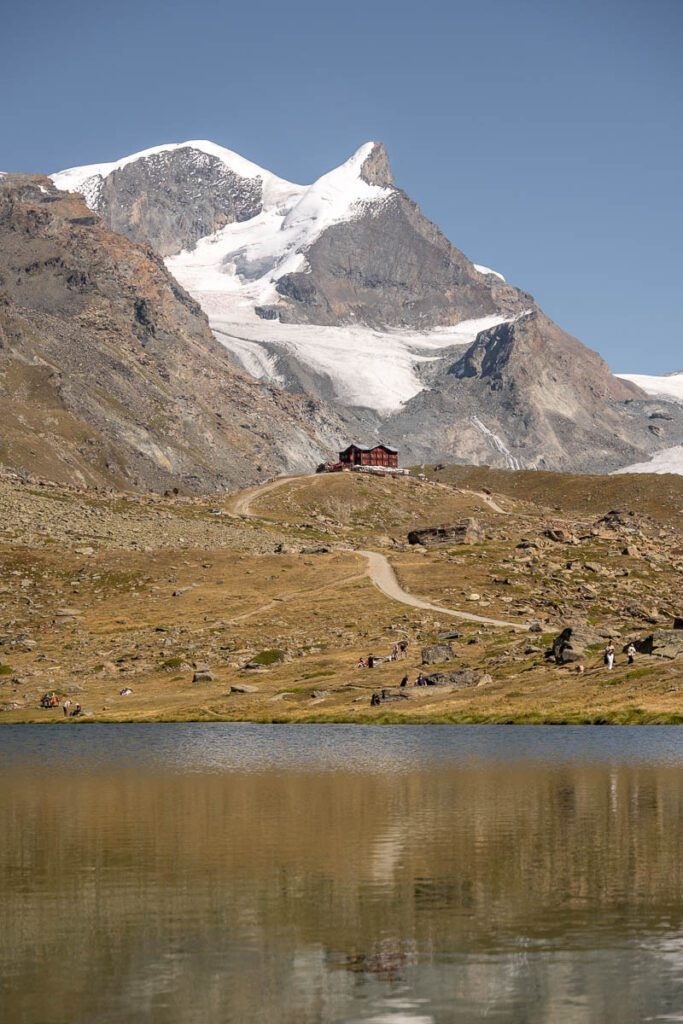
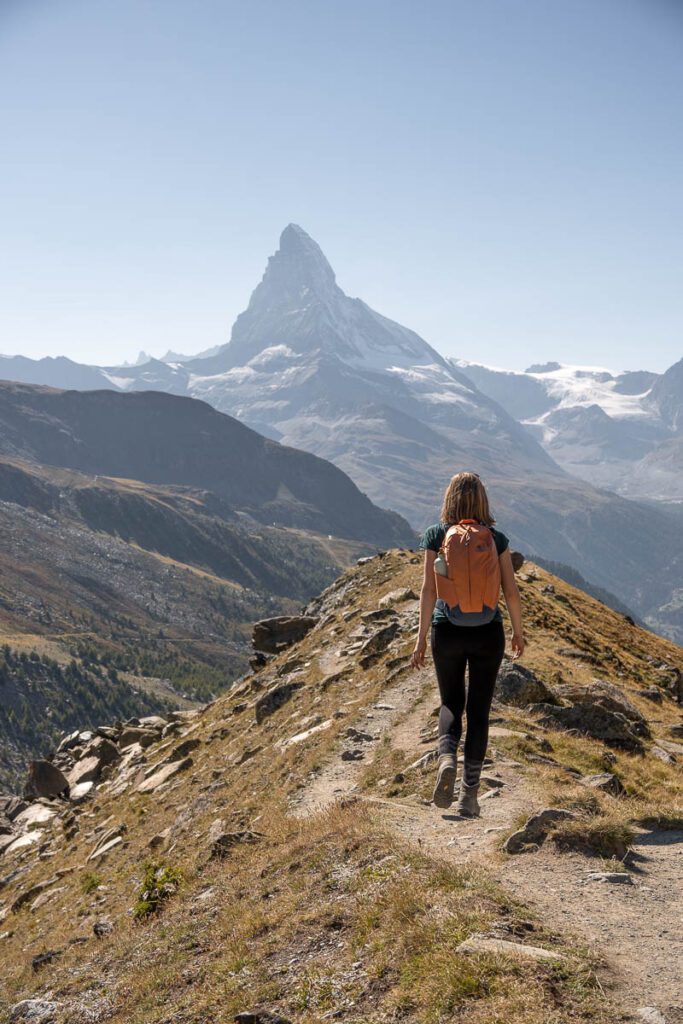

Although officially it says 3h15, it took me almost 4 hours to complete the hike with minimal photo and snack stops along the way. Make sure to calculate this in your timing, because cable cars have strict opening hours and you should be able to go back down as well. (Unless you booked a night in one of the mountain huts like Mountain Hut Fluhalp or Mountain Lodge Ze Seewjinu.)
As the hike took me longer than expected (the map I used told me it would be 2h30!), I felt a bit rushed and couldn’t really enjoy the views of the lakes. So make sure to calculate enough time and take a towel & swimsuit so you can take your time to enjoy the views!
The most beautiful part for me was without a doubt the part between Fluhalp and Grindjisee, where you walk over a ridge. A bit dangerous though!
Tip: if you want a really unique experience, book the Breakfast & Sunrise experience. It takes you to Lake Stellisee at sunrise from where you have a magical view of the Matterhorn. You’ll hike for 45 minutes at sunrise before reaching Fluhalp Mountain Restaurant where you have breakfast. I was too late to book the experience, but I heard from people I met in Switzerland that it’s absolutely worth it! Afterward, you can complete the rest of the 5-Seenweg.
If you want to take it easy, I recommend splitting Gornergrat and the 5-Seenweg into 2 separate days because doing all of this in 1 day really wrecked me. There are also plenty of other things to do in Zermatt to extend your stay!
Day 9: Zermatt – Chur – Flims
I personally think that spending 2 days in Zermatt is way too short. I could have stayed at least 2 days longer to explore more! But what do you do when you’ve booked the renowned Glacier Express? You hop on that train of course!
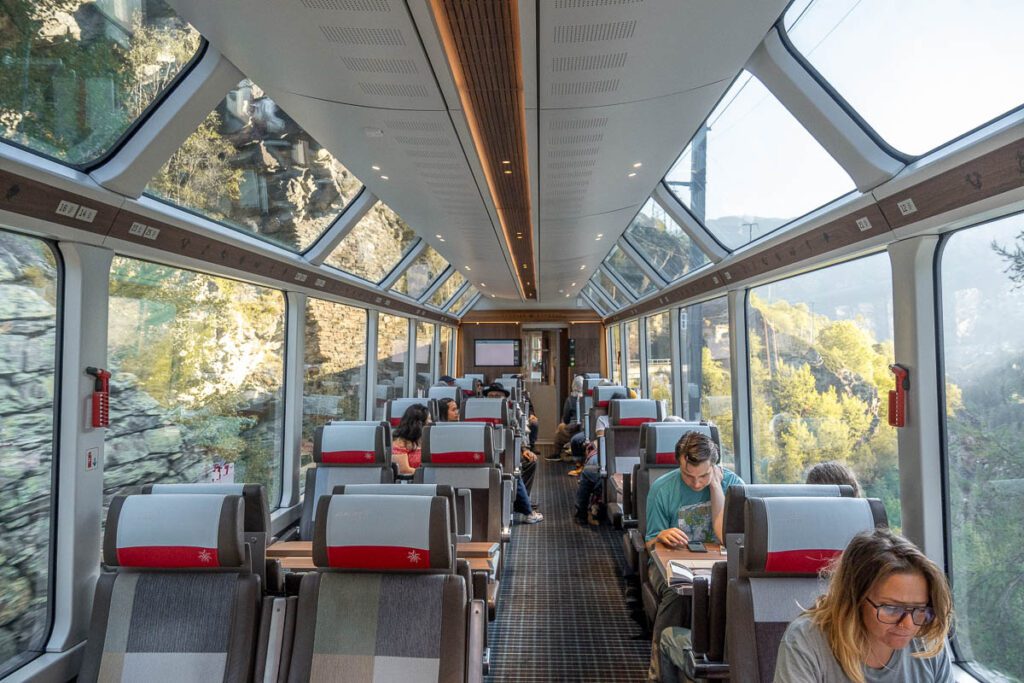
Riding the Glacier Express
That’s right, on day 9 I booked a seat in the famous Glacier Express, a luxury panoramic train that takes its passengers from Zermatt to Chur or St. Moritz and the other way around. It’s nicknamed the slowest high-speed train in the world, because the journey from Zermatt to St. Moritz takes no less than 8 hours!
With its huge windows, comfortable seats, and onboard catering, it’s definitely a luxury experience that attracts a lot of visitors. Hence, seats can be sold out weeks in advance. So if you fancy a ride on this spectacular train, you better reserve your seat early!
I traveled First Class on the Glacier Express with a 2-course meal, mostly thanks to the Swiss Travel Pass. To travel on the Glacier Express you need 2 things: (1) a valid train ticket and (2) a seat reservation. The train ticket is included in the Swiss Travel Pass, just like many other panoramic trains. As these tickets are usually quite expensive, buying the Swiss Travel Pass can save you quite some money if you’re planning to take a few panoramic trains.
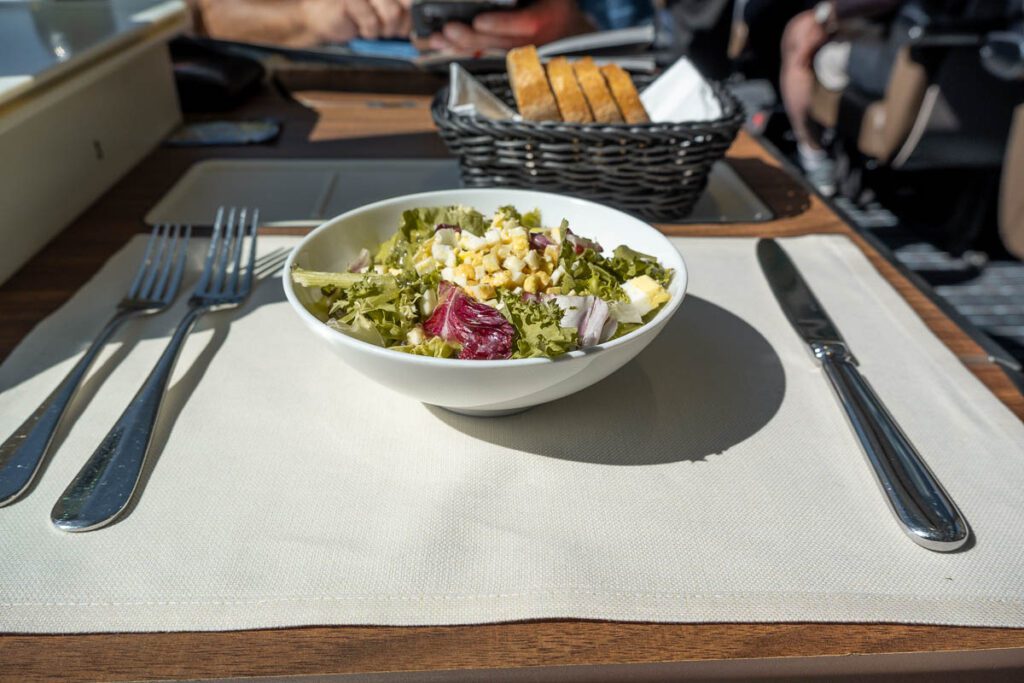

The seat reservation should be purchased separately on their website and costs 49 CHF (but can also be less depending on the period of the year and route). Be careful, you can only board the Glacier Express when you have both a ticket and a seat reservation!
Meals can be bought either à la carte on board of the train, or you can pay for a 2 or 3-course meal upfront when you make your ticket reservation. I opted for a 2-course meal, which costs 42 CHF (still a decent price). The meal was served around 12 o’clock as we would arrive in Chur after lunch.
Is the Glacier Express worth it? I found it a really pleasant experience and it’s definitely an amazing train with great service and a nice panorama, but the views I saw did not necessarily impress me more than the views I had already seen. You don’t need to book a special panoramic train to have great views in Switzerland, but of course it’s a fun experience. 🙂
Tip: go sit on the right side of the train as this has the most beautiful views! The most stunning part of the route was the Oberalppas before reaching Disentis.
Exploring Chur
The train I took had its terminal station in Chur. Upon arriving, I again dropped my luggage in one of the lockers at the train station and debarked on my exploration of the city. Chur is a real hub in the region as you can reach many ski resorts from here and it’s also the departure point of the Bernina Express, another well-known panoramic train
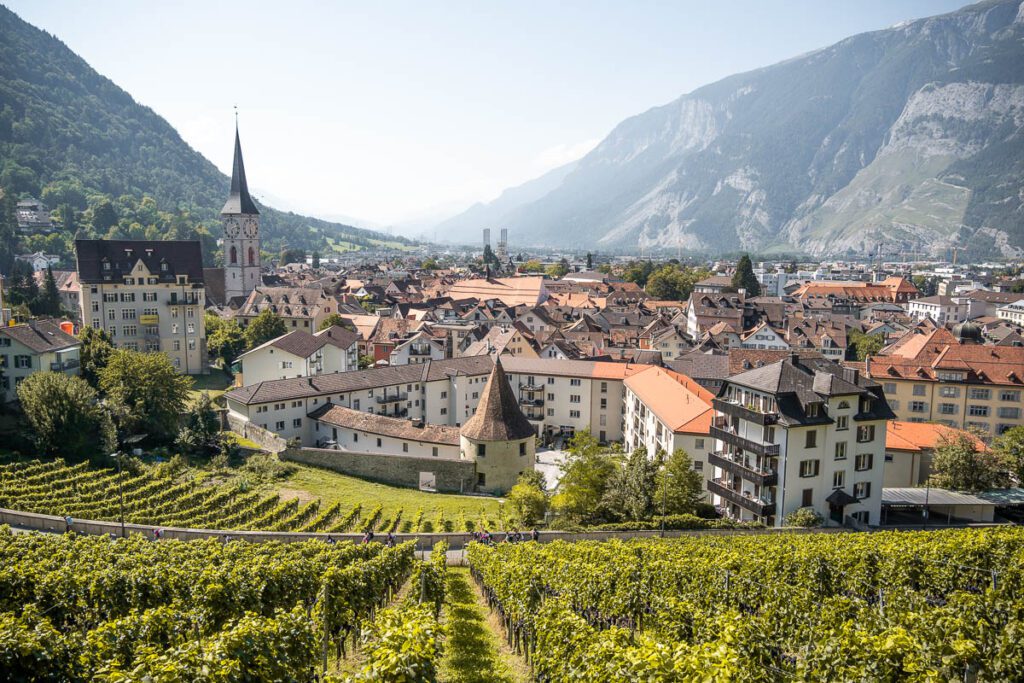
To be honest, Chur is not the most interesting place to visit in the region (unless you love mountain biking!). But it was nice to stroll around in Chur for some hours. I had the bad luck of visiting on a Sunday when most of the attractions were closed. Nevertheless, I saw some interesting places. Here’s what you should visit in Chur:
- Visit the Cathedral of Saint Mary of the Assumption – this is a beautiful cathedral with interesting catacombs you can enter.
- Have an ice cream at Evviva, the best gelato in town!
- Spot all the mural artworks located in Chur.
- Walk through the ancient Gate Tower.
- Enjoy the view at Haldenhüttli.
- Visit the Shelter for Roman Ruins (not open on Sundays…).
- Drink water from one of the unique fountains.
- Take the cable car up to Brambrüesch and go hiking or mountain biking. You can get a map at the cable car station.
- Visit one of the museums like the Bündner Kunstmuseum (art) or the Rätisches Museum (history).
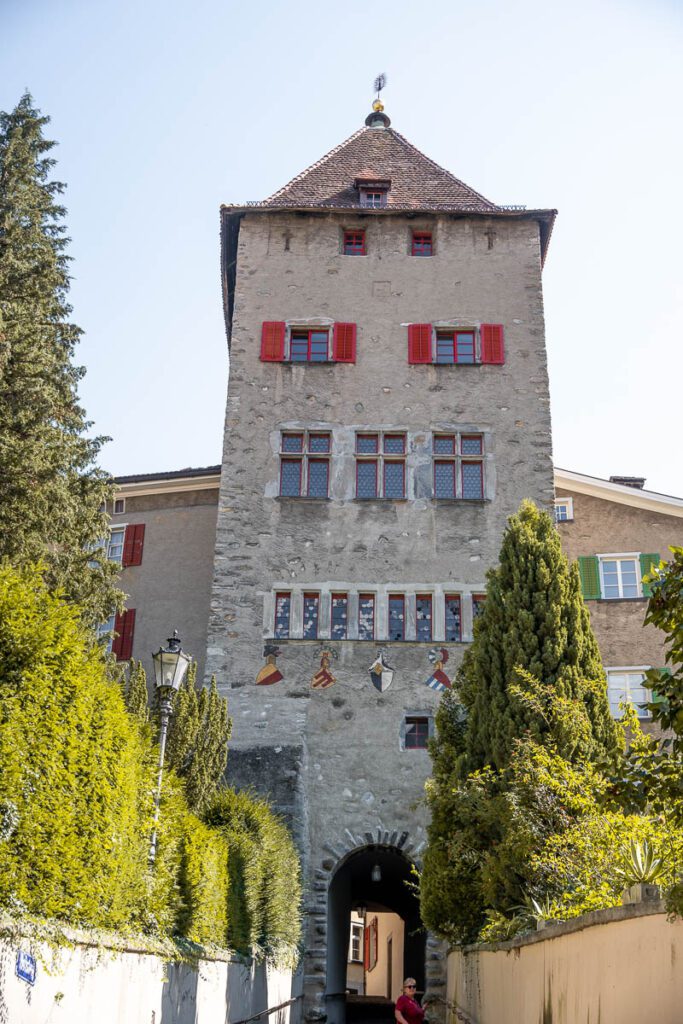

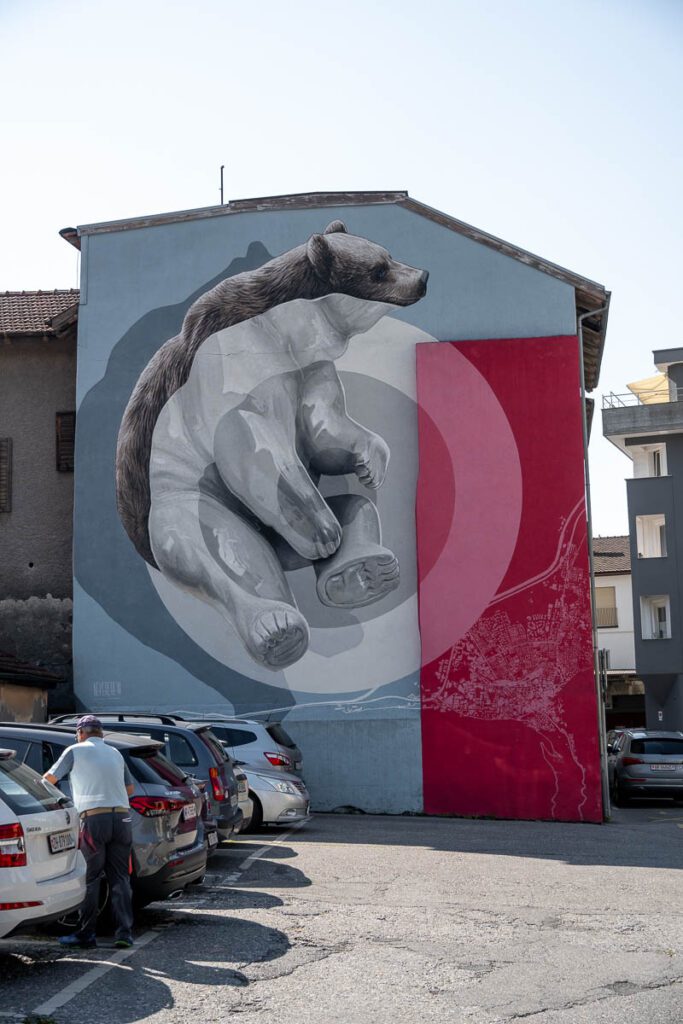
I didn’t stay in Chur for the night but took a bus to Flims instead. Never heard of Flims before? I hadn’t either, but I wanted to be out of the city and in the mountains. The place is mainly known for Caumasee, a beautiful lake, and the Trutg dil Flem, a stunning but challenging hike. Belgians might know it from the Intersoc hotel located in Flims!
During my time in Flims, I stayed at The Hide, a modern but stylish hotel conveniently located at the cable car. It also has a great restaurant, a delicious breakfast buffet, and its rooms have balconies with a stunning view!
Restaurant tip: Pizzeria Veneziana is a delicious Italian restaurant that serves freshly made pizza and pasta. Their tiramisu is also a true delicacy!
Day 10: Flims
For the one full day that I planned in Flims, it was difficult to choose between Caumasee and Trutg dil Flem. Because the latter option required a bit more preparation and an early morning I decided to hike to Caumasee and see the Grand Canyon of Switzerland.
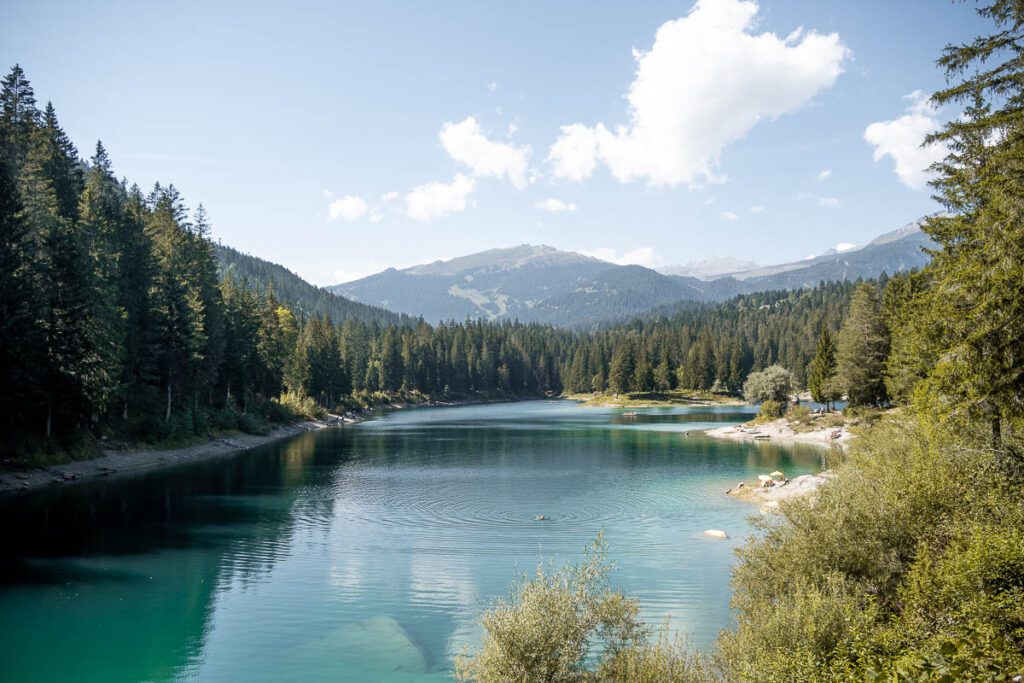
Hiking to Caumasee and the Grand Canyon of Switzerland
Yes! Switzerland has its own Grand Canyon! The Ruinaulta, a canyon-like gorge in the Anterior Rhine Valley, was formed 10.000 years ago when rocks collapsed after the retreat of an ancient glacier. Right now the Rhine is running through it, creating a fairytale-like landscape. It is THE place to go hiking, rafting, and canyoning.
Starting in Flims, you can go for an easy walk past Caumasee to the viewpoint Il Spir, where you have a stunning view of the canyon. Get yourself a hiking map at the tourist office and start exploring!
Depending on the time you have, there are several options. All of these start at the parking of Caumasee. You can opt for an easy circular hike (number 3) of just over an hour, around the lake. Or you can opt for a longer hike of 3h30 (number 14) taking you past Caumasee, viewpoint Il Spir, Crestasee, and back to Flims. Or you go for a challenging 6h50 hike (number 12) taking you all the way down in the gorge so you can walk alongside the river. The latter option starts at the Sportzentrum.

Whatever hike you choose, make sure to pack your swimsuit to take a dip in Caumasee and have your camera ready for the stunning views you’ll encounter! I hiked around Caumasee to viewpoint Il Spir and back, which was fairly easy and short. My personal favorite viewpoint was not Il Spir itself, but the view I encountered in front of Restaurant Conn. It just felt more authentic.
Restaurant tip: after my own swimming session in Caumasee, I stopped at Restaurant Cappuccino on my way back to Flims. The Italian owner is very charming and serves delicious international food. A welcome change after the many Swiss & Italian dishes I had up until then!
Day 11: Vaduz
One of the reasons why I decided to stay a few days in Flims, near Chur is because it’s not too far from the border of Liechtenstein. And since I had never visited Liechtenstein and I didn’t know anything about the country, this was the perfect occasion for a day trip. So instead of staying in Switzerland, I crossed the border for one day to the capital of Liechtenstein, Vaduz!
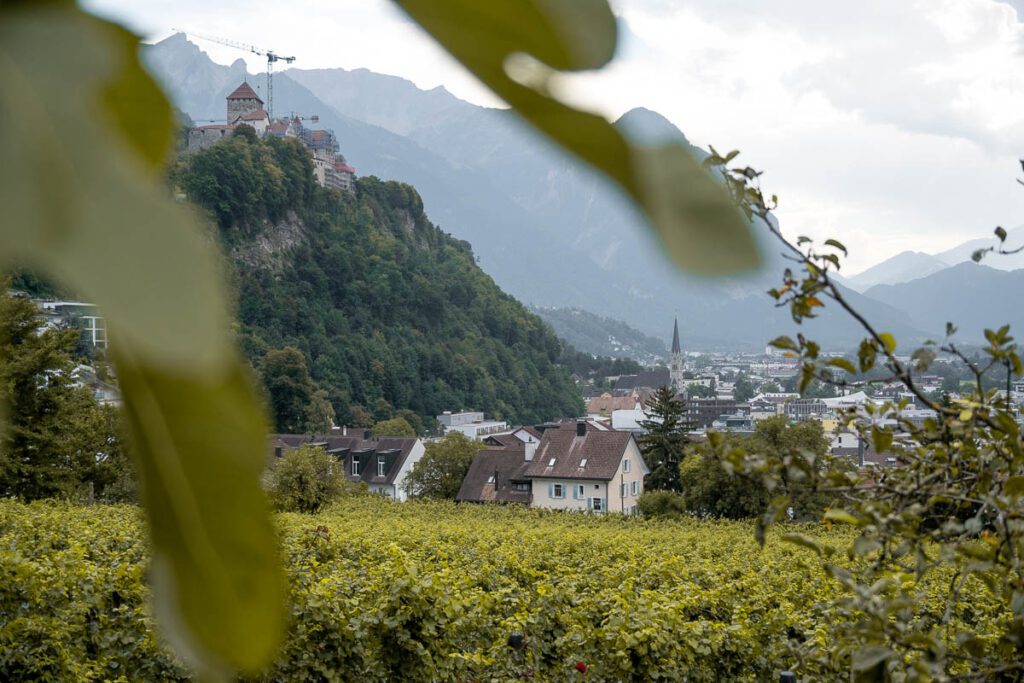
From Flims, it took me a bus (nr. 81, Flims – Chur), a train (Chur – Sargans), and another bus (nr. 12E, Sargans – Vaduz Post) before arriving in Vaduz. The entire trip was approximately 1h30. I again used the Swiss Travel Pass to cross the border as I read on the website that the pass is also valid for cross-border itineraries. However, I’m still not sure because no one checked my ticket in Liechtenstein. 😉
Get off the bus at Vaduz Post and you’re in the heart of the city center. Although the capital of Liechtenstein looks more like a small town. Until 1930, Liechtenstein had only 10.000 inhabitants. Since then the population has increased 3x as much as 50 years ago. What once used to be a small capital town is now transformed into a bustling city with lots of construction as a consequence. The country went from a rural area to a place of economic innovation.
If you – like me – don’t know anything about Liechtenstein, then there’s only 1 place to start your visit: the Liechtensteinisches LandesMuseum. This is the National Museum of Liechtenstein and explains everything about its history, culture, and habits. It’s honestly the perfect place to start to get a sense of the country. After your visit, you’ll understand so much more about what you see around you. It also features an interesting exhibition about the wildlife in Liechtenstein (and the Alps in general).
Now that you know more about the country, it’s time to visit all there is to see! Here’s what you should do:
- Go winetasting at the Cellars of the Prince of Liechtenstein. Yes! Liechtenstein has a vineyard and wine production. A royal one, because the princess herself is a sommelière and concerned with wine production. Groups can book a guided tour, but individuals can also just hop in, stroll through the vineyards, and taste a glass of wine in the tavern!
- Admire the Red House. This is one of the oldest traditional houses in Vaduz. You cannot visit the inside, but it’s worthwhile to take a look at the outside!
- Climb to the viewing platform. If you go up the hill in Vaduz, you’ll encounter a viewing platform amidst the trees. From here you have a phenomenal view of the city!
- Walk over the Alte Reinbrücke. This wooden bridge is the oldest bridge still standing over the Rhine between Switzerland and Liechtenstein. It was built in 1871 as the 3rd bridge crossing the river. Before that, people could only use ferries to go to the other side.
- Visit the St. Florin Cathedral. Because it’s so small you wouldn’t think this is the cathedral of the capital of Liechtenstein. But guess what, it is!
- Visit Kunstmuseum Liechtenstein. This museum of contemporary art is one of the highlights of Vaduz. You can visit the exhibitions and eat some artsy sushi on their terrace afterward.
- Take the bus to Château Gutenberg. Although I didn’t go up close to this castle, I’m convinced you should because it looked stunning when I saw it on the bus. You’ll encounter this on your way to Vaduz when you get out at stop Balzers, Roxy. The castle is open for individual visitors from May 1st till October 31st.
- Go hiking in Malbur. This is Liechtenstein’s only ski resort and THE place to go hiking in summer. Start your hikes at Bergrestaurant Sareis or just enjoy the view with a drink.
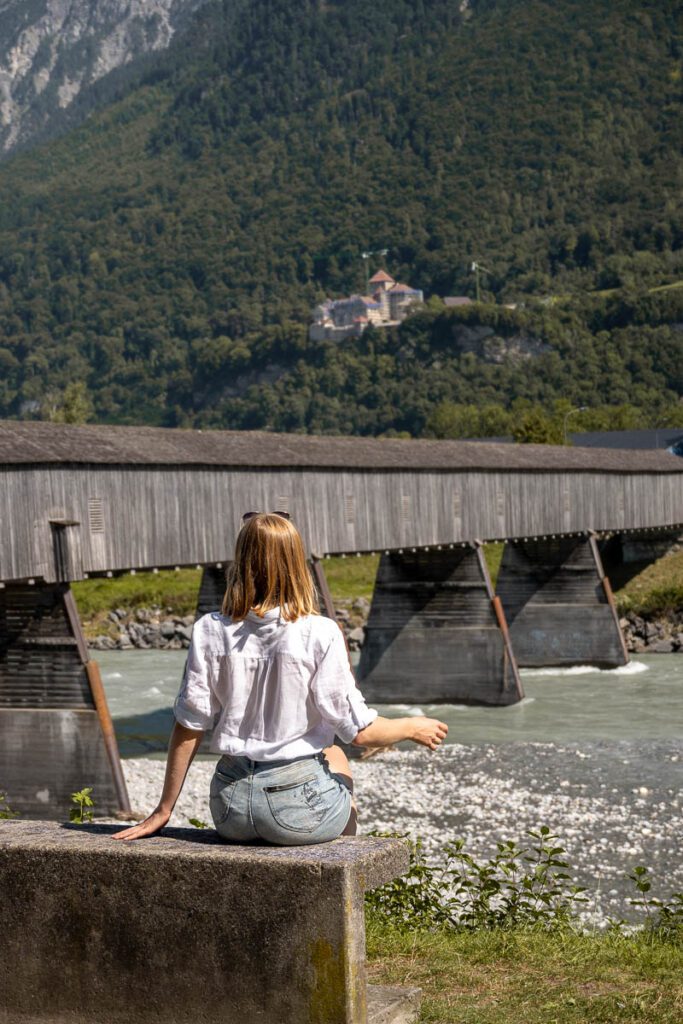
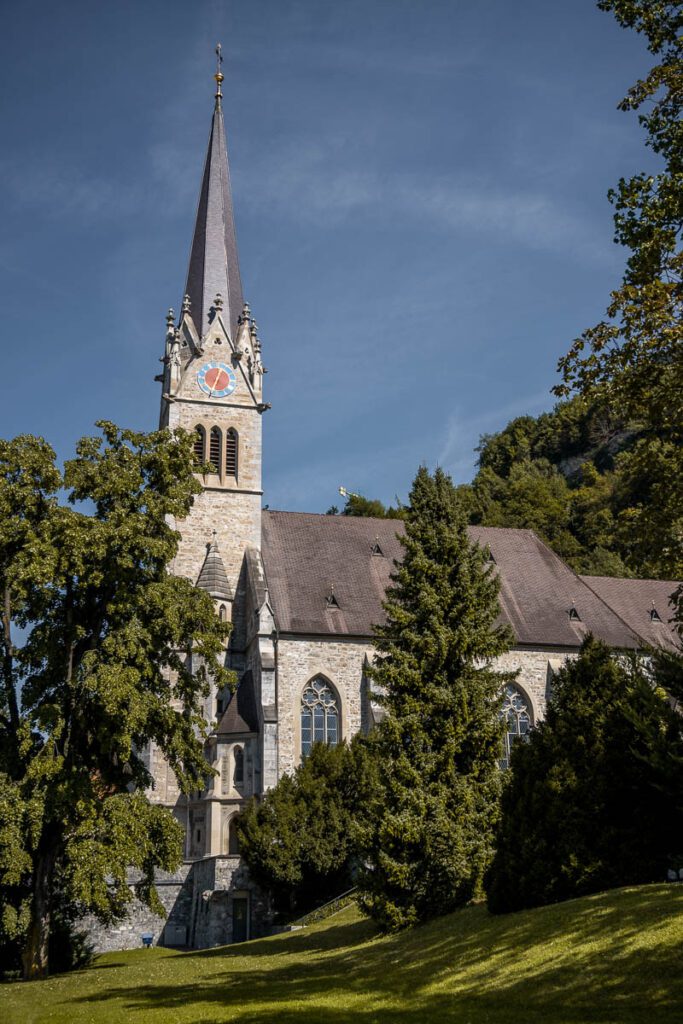

Things to know before traveling to Liechtenstein
Because Liechtenstein is a separate country, there are some things to take into account when visiting from Switzerland (or any other country for that matter).
- Liechtenstein uses the Swiss Franc as a currency. So if you’re traveling from Switzerland you can just use the Swiss Francs you already have.
- Liechtenstein is not a part of the EU but is a part of the European Economic Area, contrary to Switzerland. This means that your EU data roaming plan can be used in Liechtenstein like you would normally do. So you don’t need to be afraid of huge penalty fees like in Switzerland.
- The Swiss Travel Pass is NOT valid in Liechtenstein. Because obviously it’s only valid in Switzerland and Liechtenstein is a separate country. It is valid however on cross-border public transport.
To get back to Flims, just take bus 12E back to Sargans, the train to Chur, and bus 81 to Flims!
Restaurant tip: on my last night in Flims, I decided to try the restaurant of my hotel The Hide, called The Deli. And I can say it was a very good choice! They have a nice menu, a lovely terrace, and delicious food.
Day 12: Flims – Weggis
Day 12 was a true travel day because the connection between Flims and Weggis was not the easiest. Why Weggis? Because someone tipped me this place as being one of the most lovely villages at Lake Lucern, and he was right! Weggis is a small town at Lake Lucerne, just below Mount Rigi, a great place to go hiking. At the time of my visit, there were barely any tourists, a big contrast with the bustling touristy Lucerne.
This is what my itinerary looked like:
- bus 81 from Flims to Chur
- train from Chur to Pfäffikon
- train from Pfäffikon to Küssnacht am Rigi
- bus 502 from Küssnacht am Rigi to Weggis
In total, this journey took me almost 4 hours.
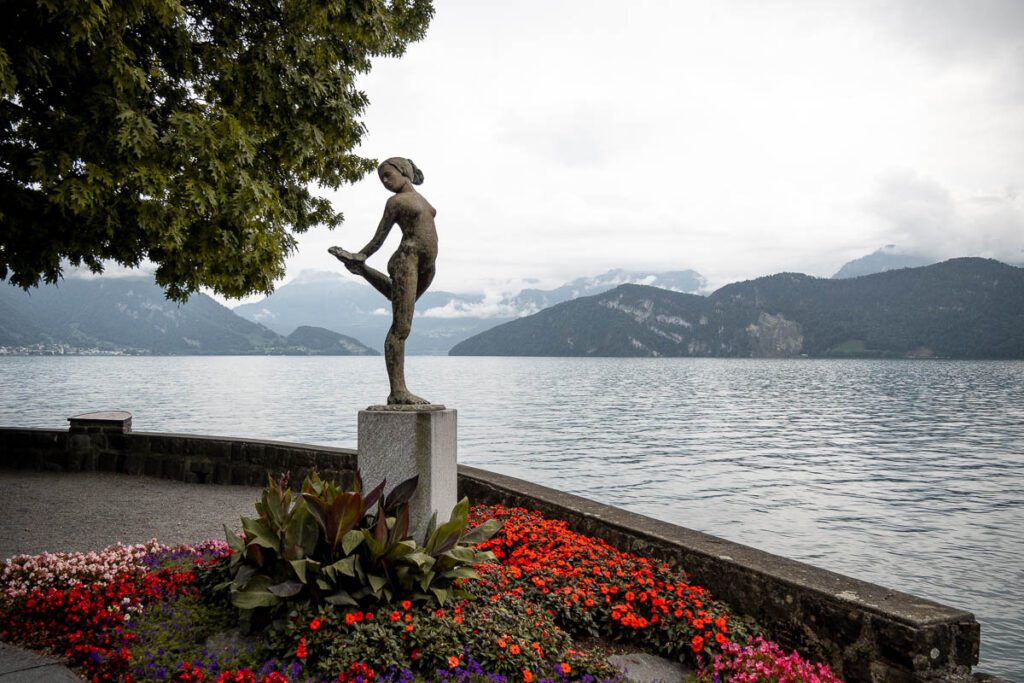

Once arrived in Weggis, I checked into Hotel Alpenblick Weggis. Although the hotel is not located in the most charming building, it definitely has the best view! Their rooms with a balcony have an amazing view of Lake Lucerne! Plus, the breakfast and restaurant are of excellent quality. Also the location is just as excellent, in 5 minutes you’re at the waterside!
As the train trip got me quite tired, I decided to take it slow and explore Weggis on foot. Of course, a stroll along the waterside couldn’t be missing! At Aussichtspunkt Weggis am See you have an excellent view of the lake but also the tiny harbour of Weggis. Its small sailboats gently bobbing against the backdrop of the impressive Mount Rigi, make it a truly picture-perfect spot.
A bit further you’ll encounter the tourist office, where you can grab a hiking map for Mount Rigi, but also hop on a boat to one of the other towns at Lake Lucerne, including Lucerne itself.
After my stroll, I went for a cake and hot chocolate or “Heisse Schoggi” in German (which is either Ovomaltine or Caotina in Switzerland) at Café Dahinden. This café was filled with locals enjoying their afternoon coffee, and located next to Lake Lucerne it was the perfect place to enjoy the view while I had the impression, for the first time in Switzerland, to be landed in a local community and not a place focused on tourism.
Restaurant tip: Hotel Alpenblick Weggis also has its own restaurant which I definitely recommend. Especially the chocolate mousse made from Toblerone is beyond delicious!
Day 13: Weggis
What else would I be doing in Weggis other than hiking? With 120km of hiking trails, Mount Rigi offers the perfect location to do so. From Weggis, you can easily take a cable car up to Rigi Kaltbad. Here you change to the train that goes up to Rigi Kulm. Tickets up Mount Rigi are included in the Swiss Travel Pass. If you don’t have this pass, a return ticket costs you 78 CHF.
At this 1.797-meter-high top, you should have a stunning view of Lake Lucerne and the surrounding region. I say “should have” because all I saw was fog and clouds. As always in Switzerland you should be lucky with the weather!

From the top, you can walk down one of the many hiking routes, including walking all the way back to Weggis. I decided to just follow the signs to wherever looked nice and non-touristy. Yes, at the top you’ll encounter many tourists, but once you start hiking you’ll leave most of the tourists behind you.
I hiked from the top all the way to Kräbel, pretty much by accident, but it was an incredibly beautiful route! This took me around 2-3 hours. 95% of the trail, I didn’t cross anyone else. However, I did pass by a cheese farm where you could stop for a drink and taste some delicious locally-made cheese, called the Chäserenholzhütte. Not to mention the numerous cows with jingling bells I crossed on the way down!
The second part of my hike just went through random fields. The trail was marked by a yellow pole once in a while but I basically walked from one pasture full of grazing cows to another. Quite an adventure because the trail was not always that easy to find. But do I recommend it? Yes! (You should not be afraid of cows though.)

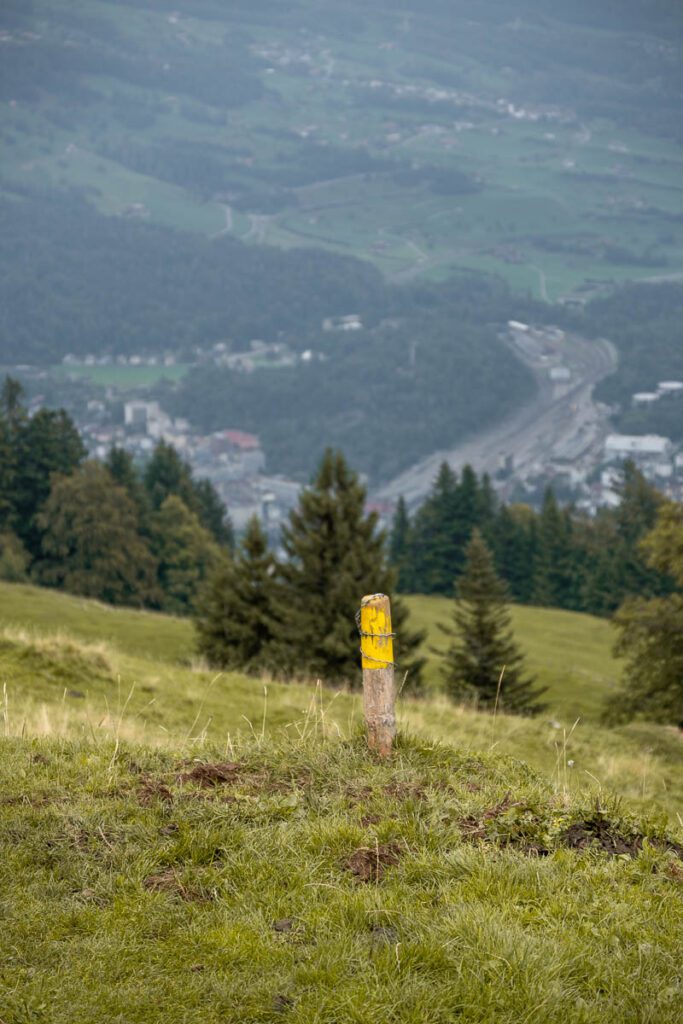
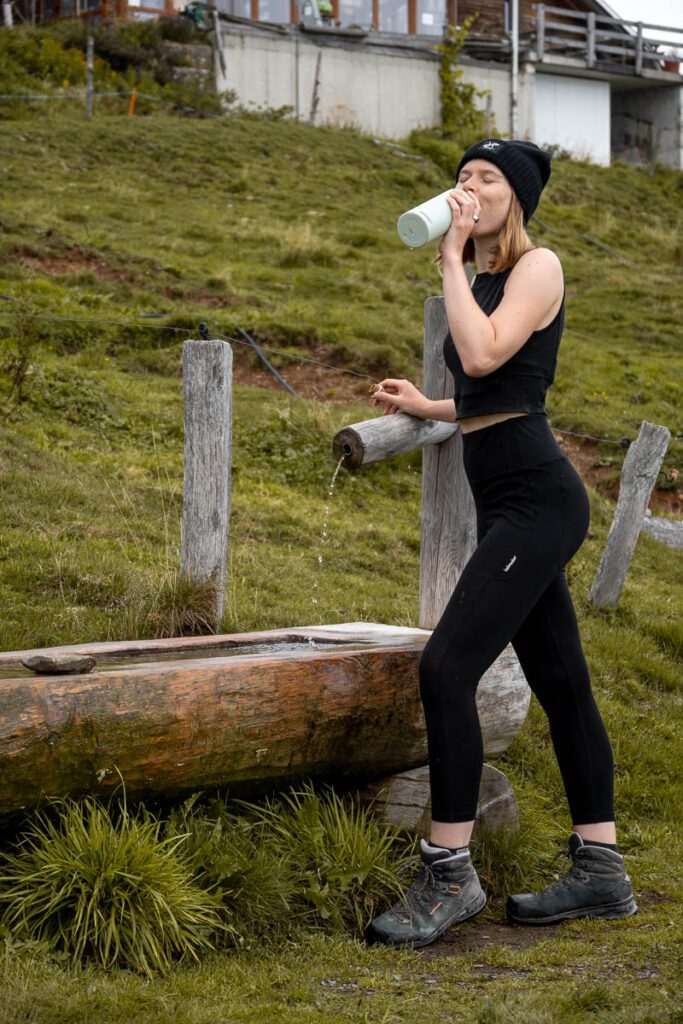
Once arrived at Kräbel I took the train back to Rigi Staffel. I was lucky to only have to wait 5 minutes for the train because it only runs once an hour. Hence, make sure to check the timing! At Rigi Staffel, I changed trains to go to Rigi Kaltbad and then took the cable car back to Weggis. The ending of a wonderful day!
Restaurant tip: that evening I went dining again at Hotel Alpenblick Weggis because I absolutely did not feel like searching for another spot, although I was tempted to try Restaurant Seerose because they have the best view of the lake while dining. If you would try it, let me know your thoughts!
Day 14: Weggis – Luzern
My absolute favorite activity at Lake Lucerne was taking the boat from Weggis to Lucerne. And that’s exactly what I did on my last full day in Switzerland!
In the center of Weggis, next to the tourism office, you’ll find the dock where you can board the ship to Lucerne (but also to the other towns at Lake Lucerne of course). Every hour (or 2 hours outside the peak season) you can board a ship in the direction of Lucerne. This ship is included in the Swiss Travel Pass. If you don’t have the pass you pay 22 CHF for a single ride.
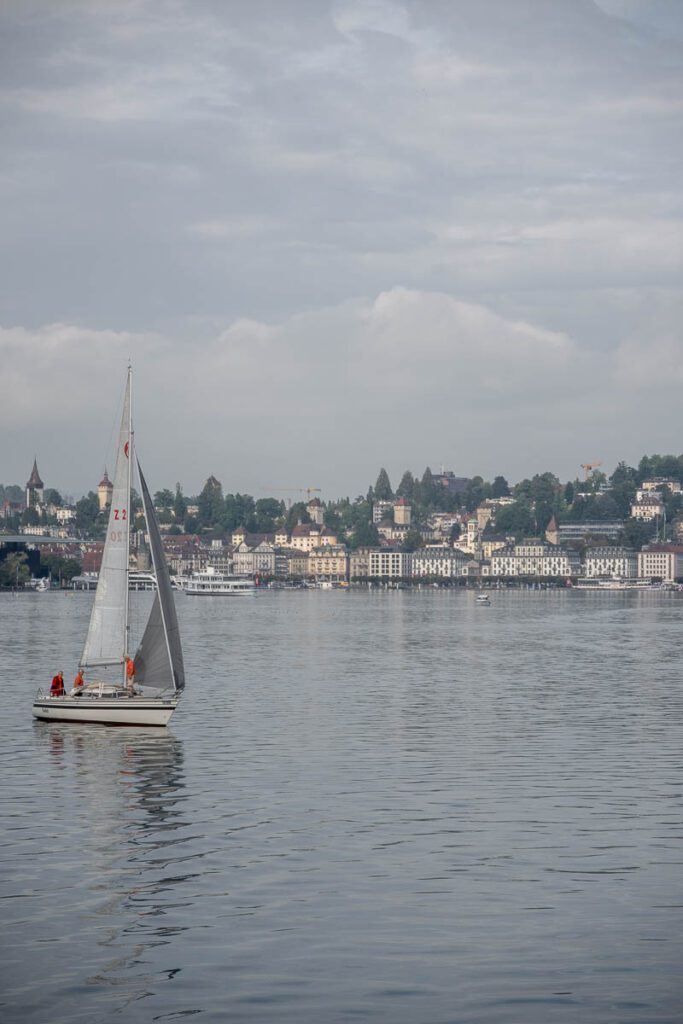
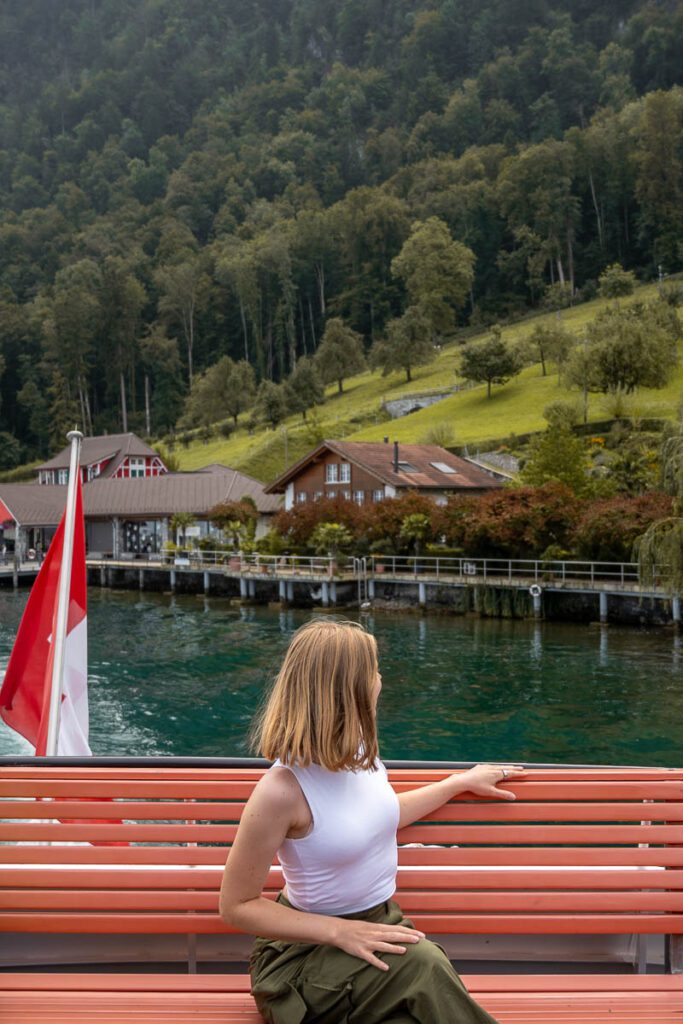

On the ship, there is a first and a second class. The first class has access to the upper deck from where you’ll have a better view during the boat ride. So if you feel like it, definitely go for an upgrade. It will be less busy as well and thus more enjoyable. The Lake Lucerne Navigation company even organizes theme cruises with burgers or Mexican nights.
Once arrived in Lucerne, I locked my luggage in the train station and immediately went exploring the city. Lucerne is a buzzing city with a lot of tourists, especially compared to the rather unknown Weggis. Here’s what you should definitely see on a day trip in Lucerne:
- Chapel Bridge – this is probably the most photographed spot of Lucerne. This covered bridge with painted panels is one of the highlights of the city and is so romantic!
- Spreuerbrücke – not many people know that Lucerne actually has 2 of these covered bridges, this is the second one and just as beautiful!
- Jesuit Church – this magnificently decorated church is definitely worth a 5-minute stop.
- Museggmauer – a part of the ancient city wall is still standing, including some of its towers. Nowadays you can walk over the walls and enter some of the towers such as the clock tower and Männliturm. From here you have stunning views of the city!
- Glacier Garden – this park/museum gives you an interesting insight into the history of the earth, more specifically the Alpine environment. Plus, it’s free with the Swiss Travel Pass.
- Lucerne Promenade – at Lucerne’s waterside you’ll find a nice promenade where you can go for a refreshing stroll with a nice view.
- Church of St. Leodegar – another beautiful church in Lucerne with an interesting graveyard.
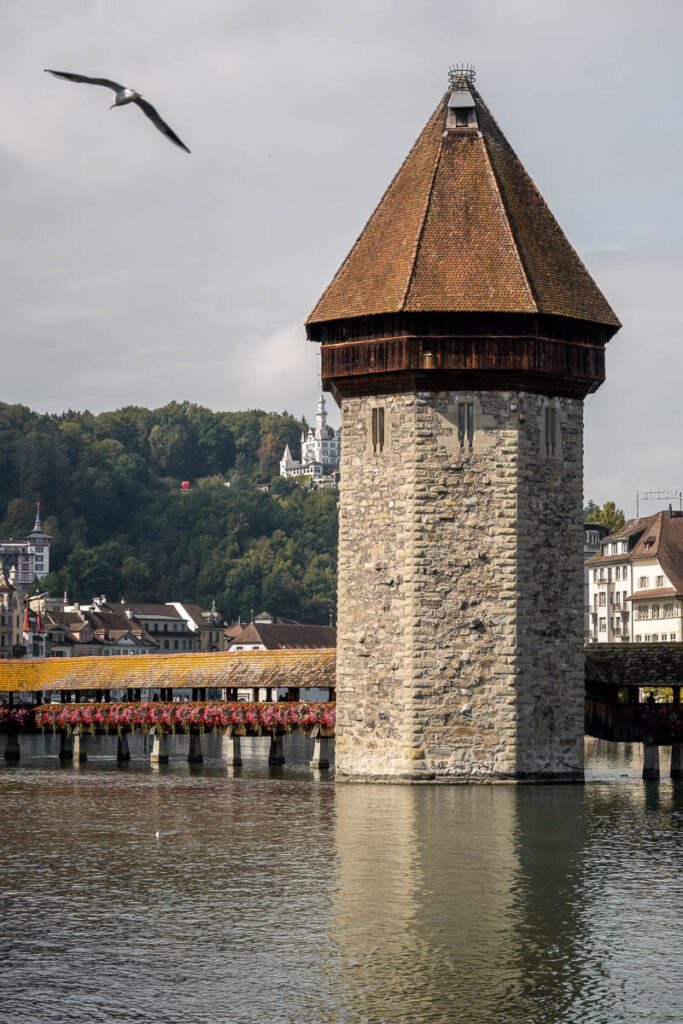

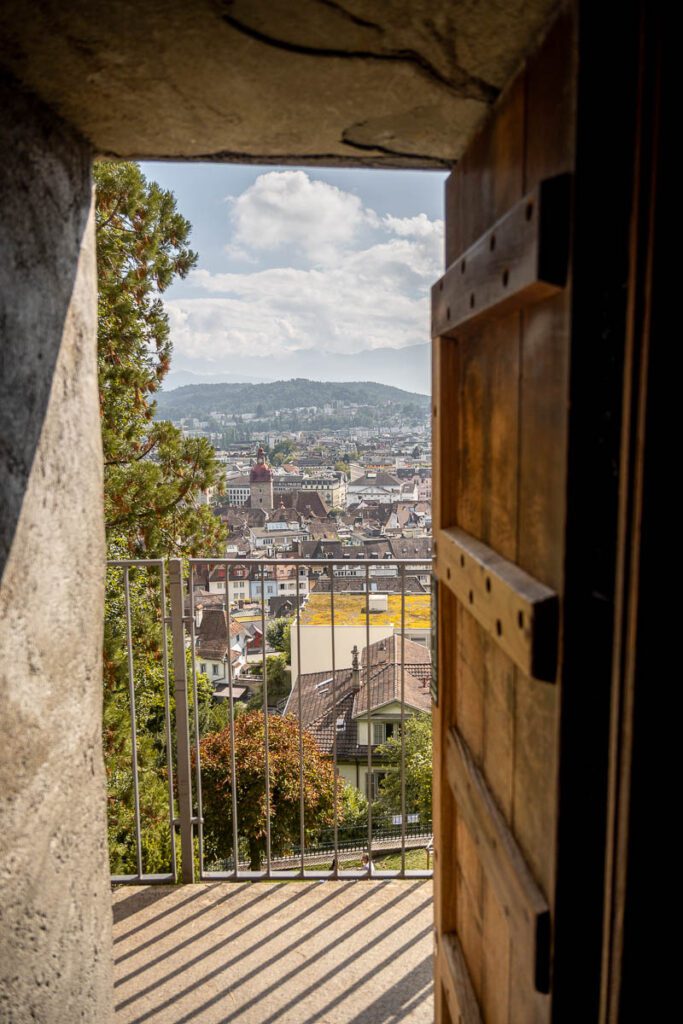
Restaurant tip: I had lunch in Café Bar Lokal where they serve delicious salads, kinds of pasta, and smaller snacks. Recommended!
Hotel tip: I stayed in Hotel Anker Luzern, a cute small hotel in the old city center.
Day 15: returning to Belgium
After 2 full weeks of solo traveling in Switzerland and countless unforgettable experiences, it was time to head home. With a heavy heart, I took the train from Lucerne to Basel (which is around an hour). In Basel, I boarded an ICE train to Köln where I changed to a train to Brussels. Actually, I should have, but because of problems the ICE did not leave in Basel, and I had to take 2 extra trains to finally end up on the ICE. Quite a hassle!
I booked all my international train tickets through NMBS International as it’s super convenient, but I would advise you to travel via France and not Germany as I always have trouble when traveling over Cologne by train.
If you feel like planning your own train trip to Switzerland, definitely go check out the website of the Swiss Tourism Board. They have a lot of information about the most beautiful train routes, which they call the Grand Train Tour. And also don’t forget to look into the Swiss Travel Pass for a stress-free journey!
Some additional tips
- Buy a Swiss Travel Pass, with this pass you can use any public transport (trains & busses) in Switzerland, and it also gives free access to a lot of museums. It’s definitely worth it if you’re taking one of the more expensive panoramic trains.
- Download the SBB Mobile app. This is the application of the Swiss railways where you can look up all the train connections.
- You don’t really need Swiss Francs. Most places either accept cards (credit cards, Apple Pay…) or euros so you don’t really need to have Swiss Francs except for some coins to use at the lockers of the smaller train stations.
- Plan certain activities beforehand, such as the Jungfraujoch and the Glacier Express. You’ll need seat reservations for these which are booked out quite early!
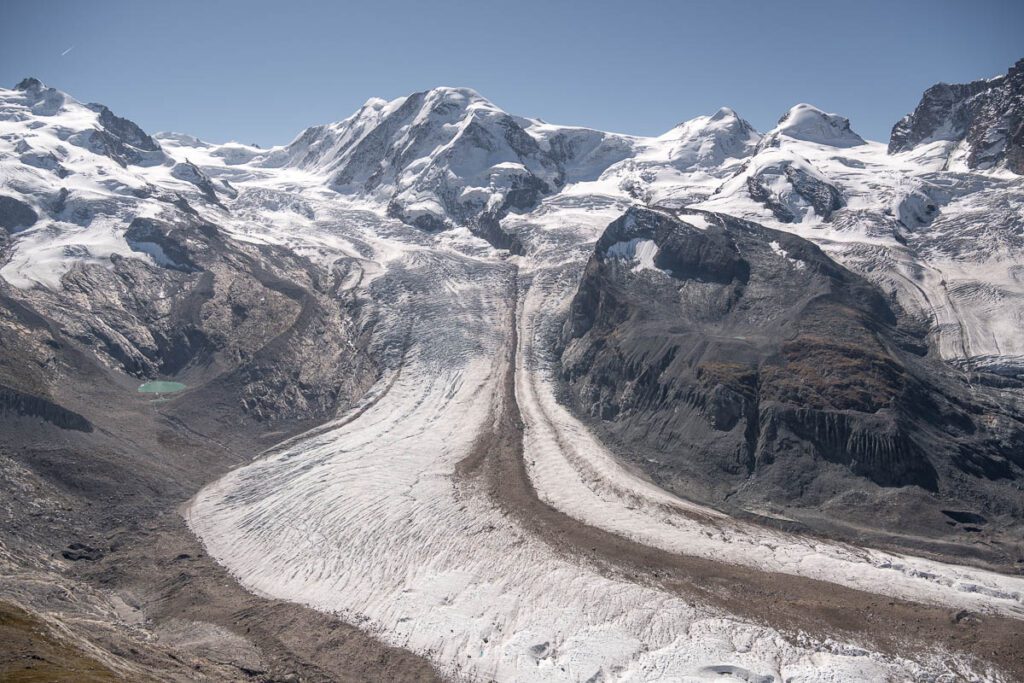
FAQ
What is the Swiss Travel Pass?
The Swiss Travel Pass is a pass for all public transport in Switzerland. You can buy one for 1 day or up to 2 weeks. With the pass, you can use all trains, buses, and some cable cars without limit. Even the famous panoramic trains such as the Glacier and Bernina Express are included! Plus, it gives you free access to over 500 museums.
How much does a 2-week train trip in Switzerland cost?
THE question I get asked all the time: ‘how much did your 2-week trip in Switzerland cost?’ The truthful answer is that I don’t know and don’t want to know ;). Joking, but also not joking. I never tracked all my expenses to the exact euro cent, but I estimate it to be between 3.000 – 4.000 euros. Take into account that I always stayed in hotels and ate out every evening. So you can definitely save a lot of money by sleeping in hostels and cooking your own meals.
What about data roaming in Switzerland?
This is important! You cannot use your regular data plan like in other European countries because it will cost you a ton of money. Instead, you should either buy a separate plan with your current provider, buy a local SIM card, or get an eSIM. The latter option is definitely the most convenient! I bought an eSIM with 10 GB of data through Nomad. You can find more info about the eSIM I bought in this blog post.

